Kangaroo Island, located off the southern coast of Australia, is known for its abundant wildlife, including a diverse array of bird species.
The island’s unique geography and varied ecosystems, which range from eucalyptus forests to coastal shrubland and grassy plains, provide ideal habitats for many different types of birds.
The island’s birdlife is characterized by its colorful and charismatic species, such as the glossy black cockatoo, the fairy penguin, and the rare osprey.
From birdwatchers to nature enthusiasts, Kangaroo Island offers a fascinating glimpse into Australia’s avian diversity, making it a must-visit destination for anyone who loves birds.
1. Painted-Snipe
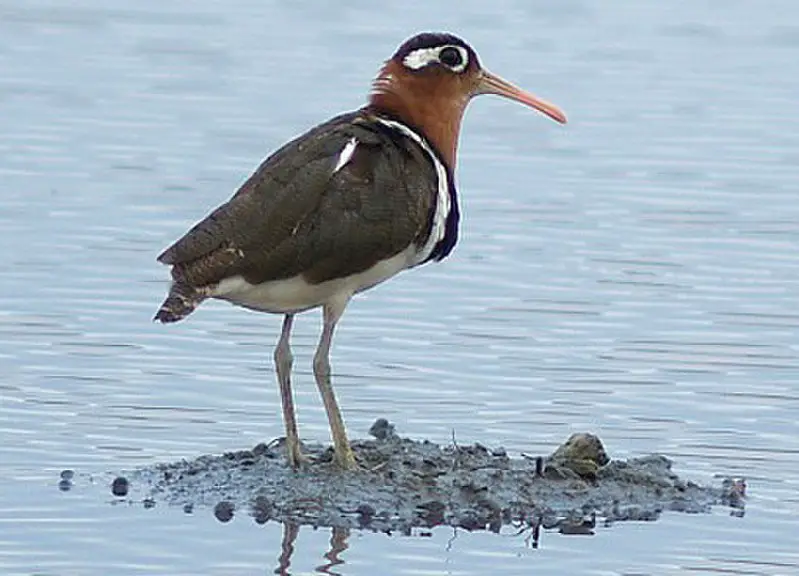
Painted snipes are beautiful and unique wading birds found in the Rostratulidae family. They have short legs, long bills, and a striking plumage which distinguishes them from true snipes.
Males tend to be smaller than females with duller overall coloration. There are three species of painted snipe.
The Greater Painted Snipe, Lesser Painted Snipe, and Australian Painted Snipe – all three have different habitats ranging from wetland pools to grasslands or mangroves depending on their region.
These birds feed mainly on earthworms but also consume insects, crustaceans and plant material when available.
As they rely heavily on wetlands for breeding purposes it is important that we protect these precious habitats so that this special bird can continue to thrive.Scientific classification:
| Kingdom | Animalia |
| Phylum | Chordata |
| Class | Aves |
| Order | Charadriiformes |
| Suborder | Thinocori |
| Family | Rostratulidae Coues, 1888 |
Also Featured In: Most Common Birds in China, Birds that Live in Tamil Nadu
2. Stone-Curlew

Stone-curlews, also known as dikkops or thick-knees, are a family of birds that have adapted to live in tropical and temperate regions throughout the world.
They can be found in Africa, Asia and Australia with two or more species per region. Despite being classified as waders, most prefer dry arid habitats over moist wetlands.
Stone-curlews typically have long legs which help them navigate through their preferred terrain efficiently; some species even stand at an impressive height when standing on those long legs.
Additionally they feature cryptic plumage which helps them blend into their surroundings while hunting for prey such as insects and small mammals like rodents.
These unique bird’s calls are easily recognizable; it has been said that hearing one is similar to listening to someone whistling ‘Keee Weee’.Scientific classification:
| Kingdom | Animalia |
| Phylum | Chordata |
| Class | Aves |
| Order | Charadriiformes |
| Suborder | Chionidi |
| Family | Burhinidae Mathews, 1912 |
Also Featured In: Beautiful Brazilian Birds, Common Uzbekistan Birds
3. Bee-Eater
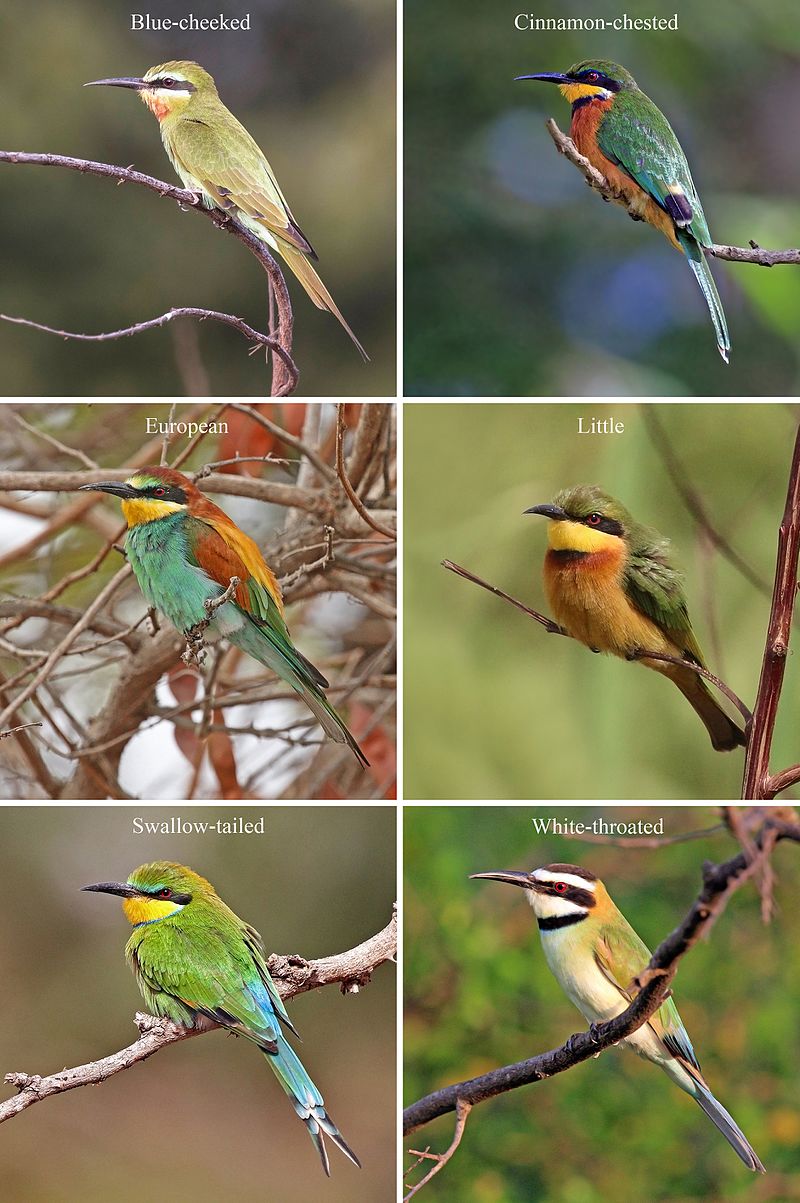
Bee-eaters are one of the most beautiful and vibrant birds in existence. They have a slender body, long wings, down turned bills and their signature elongated central tail feathers which make them instantly recognizable from afar.
Their plumage is incredibly colorful with many shades ranging from blues to greens to reds that glisten when they fly through the air.
These stunning creatures can be found all over Africa, Asia, Southern Europe, Australia and New Guinea where they feed mainly on bees but also other insects like flies or wasps as well as small mammals such as lizards or rodents.
Bee-eaters live in colonies near rivers or wetlands so that they may easily hunt for food while staying close together for safety purposes.
Additionally it allows them to better display their impressive courtship dances during mating season.Scientific classification:
| Kingdom | Animalia |
| Phylum | Chordata |
| Class | Aves |
| Order | Coraciiformes |
| Family | Meropidae Rafinesque, 1815 |
Also Featured In: Common Nigerian Birds, Turkey Birds You Should Know
4. Darters
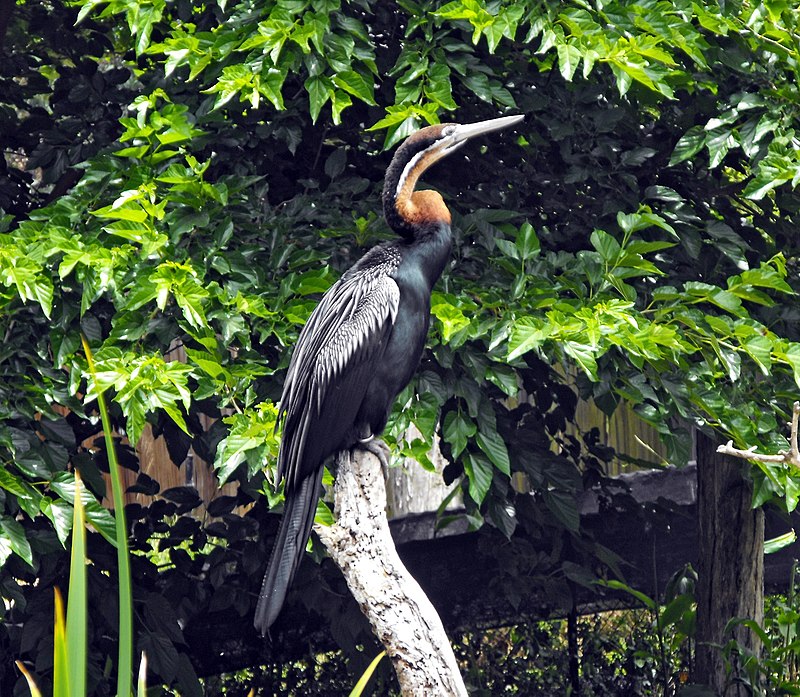
Darters are tropical waterbirds from the family Anhingidae, which includes four species. Three of these species are common and found in multiple locations while one is rarer and classified as near-threatened by IUCN.
Their most notable feature is their long neck which they use to dive into shallow waters for prey such as fish or frogs.
They have a slim body with large wings allowing them to soar high in the sky at great speeds making it difficult for predators to catch them during flight.
Darters also make regular visits to land where they bask in the sun on tree branches or rocky outcroppings.
These birds can be easily identified by their dark feathers, yellowish eyes, and orangey beak – all features that help distinguish them from other birds of similar size and coloration.Scientific classification:
| Kingdom | Animalia |
| Phylum | Chordata |
| Class | Aves |
| Order | Suliformes |
| Family | Anhingidae Reichenbach, 1849[1] |
| Genus | Anhinga Brisson, 1760 |
Also Featured In: Most Common Types of Bangladeshi Birds, Water Birds Live around Us
5. White-Eyes

White-eyes are small passerine birds found in a variety of tropical, subtropical and temperate environments.
They inhabit most islands in the Indian Ocean, western Pacific Ocean and Gulf of Guinea.
The family Zosteropidae includes many species which are endemic to single islands or archipelagos – they can’t be seen anywhere else on Earth.
White-eyes have distinctive white feathers around their eyes giving them their name, while some also feature yellow plumage or bright red patches at the throat.
These pretty little birds feed mainly on insects such as beetles and caterpillars but will also eat nectar when available.
With their friendly nature, white-eyes make great garden visitors who often come close enough for you to watch up close with binoculars.Scientific classification:
| Kingdom | Animalia |
| Phylum | Chordata |
| Class | Aves |
| Order | Passeriformes |
| Superfamily | Sylvioidea |
| Family | Zosteropidae Bonaparte, 1853 |
Also Featured In: Common Birds in Japan, Asian Birds
6. Frogmouth
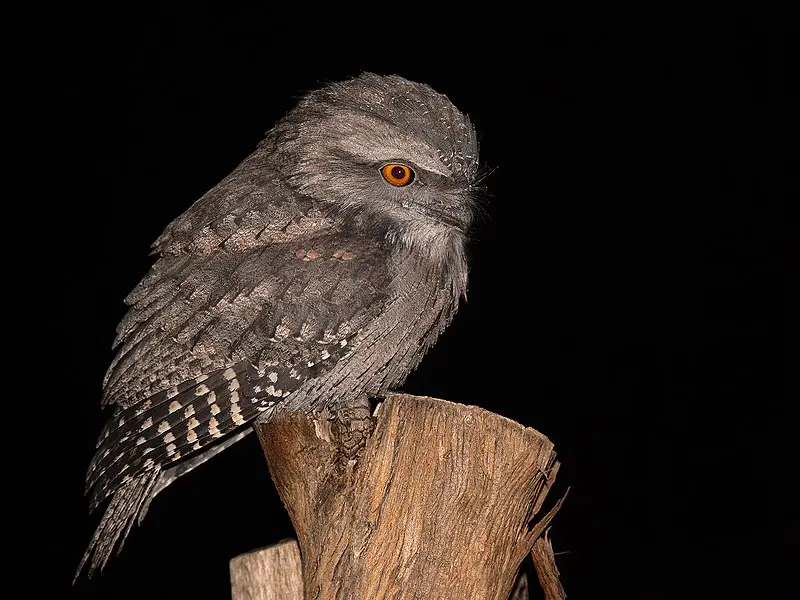
The Frogmouth is a nocturnal bird that belongs to the same family as owlet-nightjars, swifts and hummingbirds.
They have large flattened hooked bills with huge frog-like gape which helps them capture insects during night time.
Three species of Podargus are found in Australia and New Guinea only – they have massive eyes that allow for excellent night vision.
Their bodies are generally grey or brownish in colour with cryptic markings for camouflage when roosting during day light hours.
Generally known as quiet birds, their loud wailing call can be heard at dusk or dawn near river banks or wetlands where they live alone or form pairs throughout breeding season.
The diet of these fascinating creatures consists mainly of flying insects such as moths, beetles & cicadas etc., but on occasion will consume small vertebrates like lizards and frogs too.Scientific classification:
| Kingdom | Animalia |
| Phylum | Chordata |
| Class | Aves |
| Clade | Strisores |
| Order | Podargiformes Matthews, 1918 |
| Family | Podargidae Gray, 1847 |
Also Featured In: Birds of the Philippines, Common Philippines Birds
7. Procellariidae
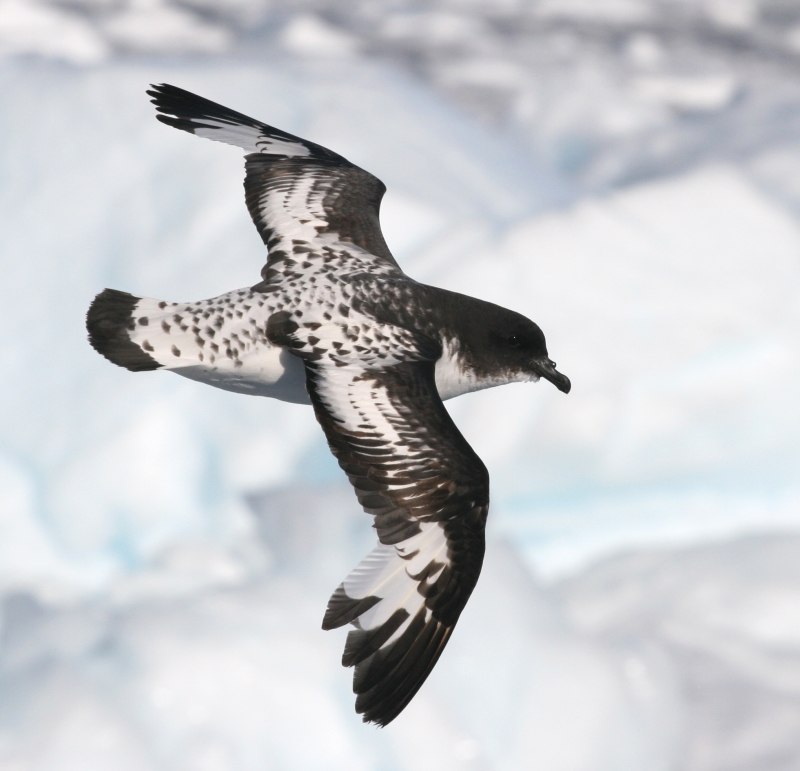
Procellariidae is a diverse family of seabirds belonging to the bird order Procellariiformes.
These birds are commonly referred to as tubenoses and include fulmarine petrels, gadfly petrels, diving petrels, prions, and shearwaters.
They range in size from the small storm-petrel which measures around 18cm long to the giant albatross which can reach up to 3 meters in length.
Generally found near oceans or coasts where they feed on fish as well as squid and other marine life depending on species.
Many procellariids will also nest inland during breeding season before returning back out at sea for most of their lives.
Their wings have specially adapted feathers that give them incredible gliding abilities allowing them literally fly with minimal effort over vast distances across oceanic regionsScientific classification:
| Kingdom | Animalia |
| Phylum | Chordata |
| Class | Aves |
| Order | Procellariiformes |
| Family | Procellariidae Leach, 1820 |
Also Featured In: Most common Birds in France, Birds You’ll Find in the Sea
8. Threskiornithidae
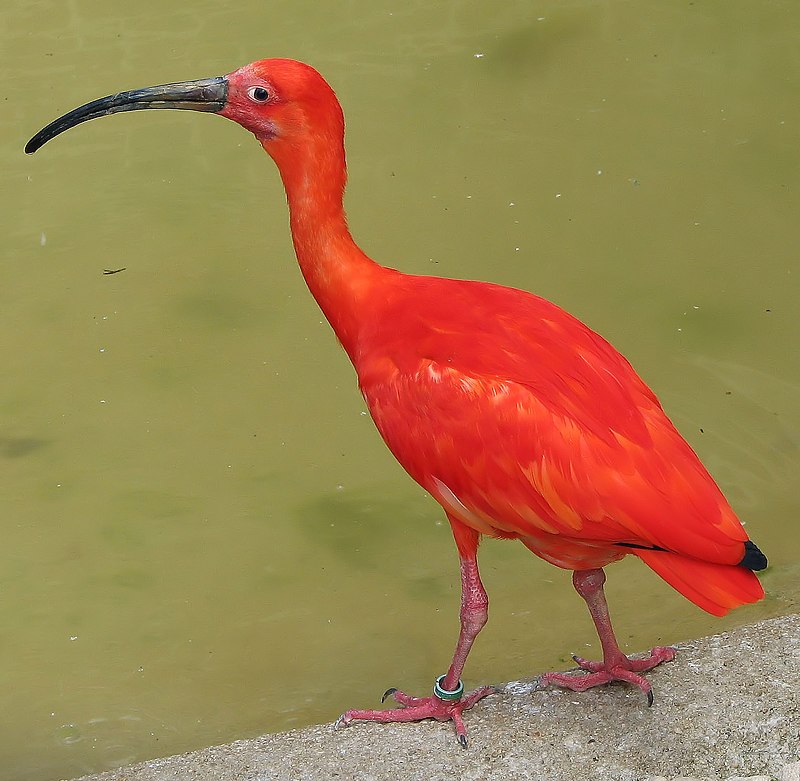
Threskiornithidae is a family of large wading birds which includes 36 species. These birds are traditionally divided into two subfamilies – the ibises and the spoonbills.
However, recent genetic analysis has shown that spoonbills actually belong to Old World ibis group, while New World ibises form an early offshoot from this lineage.
Threskiornithidse members have long curved beaks with serrated edges used for catching fish in shallow water or mudflats, as well as other aquatic invertebrates like crustaceans and mollusks.
They also feed on plant matter such as grains and seeds found close to wetlands areas where they live.
This diverse diet makes them important scavengers in their ecosystems, helping maintain healthy populations of native wildlife by controlling insect numbers and dispersing energy-rich seeds throughout wetland habitats.Scientific classification:
| Kingdom | Animalia |
| Phylum | Chordata |
| Class | Aves |
| Order | Pelecaniformes |
| Suborder | Ardei |
| Family | Threskiornithidae Richmond, 1917 |
Also Featured In: Most Common Romanian Birds, Native Birds of Kazakhstan
9. Skuas
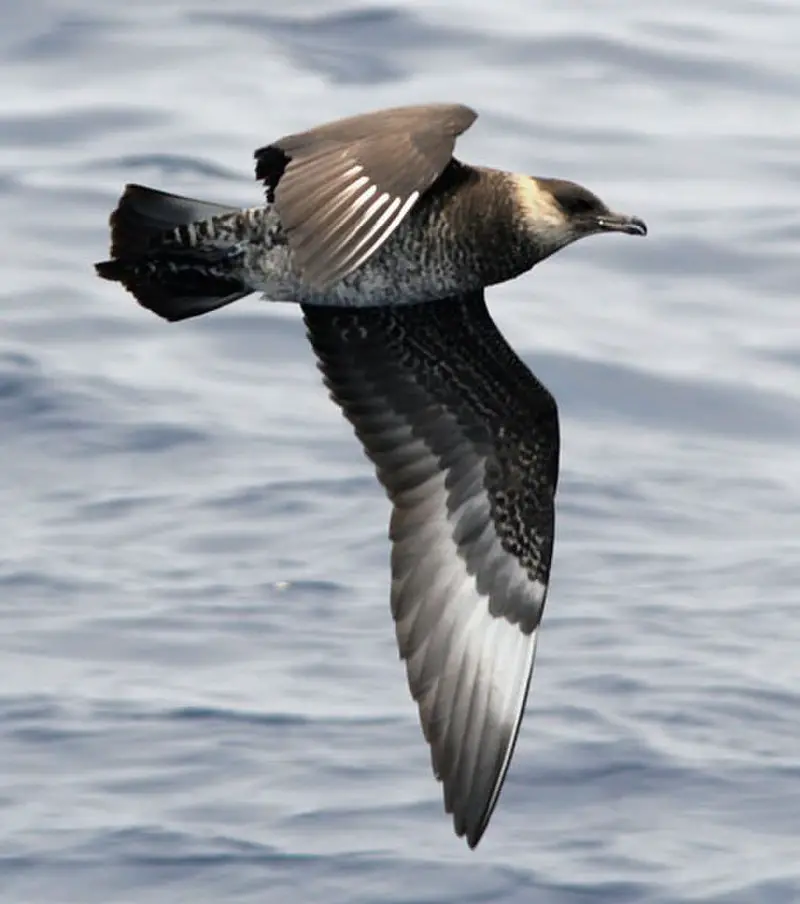
Skuas are a group of predatory seabirds with seven species, all belonging to the genus Stercorarius.
They are also known as “Jaegers” in North America and their name originates from the Faroese word for Great Skua – skúgvur.
These birds typically inhabit coastal areas or open oceans where they feed on fish, krill and other marine creatures.
Skuas can be distinguished by their pointed wings which help them fly long distances while hunting food.
Their distinctive colouration varies depending on age and habitat but generally includes greyish brown upperparts and white underparts with black streaks along its belly area.
The overall size ranges from 24-40 cm making these one of the larger sea bird species.Scientific classification:
| Kingdom | Animalia |
| Phylum | Chordata |
| Class | Aves |
| Order | Charadriiformes |
| Suborder | Lari |
| Family | Stercorariidae Gray, 1871 |
| Genus | Stercorarius Brisson, 1760 |
Also Featured In: Birds of Morocco, Italian Birds You Should Know
10. Buttonquail
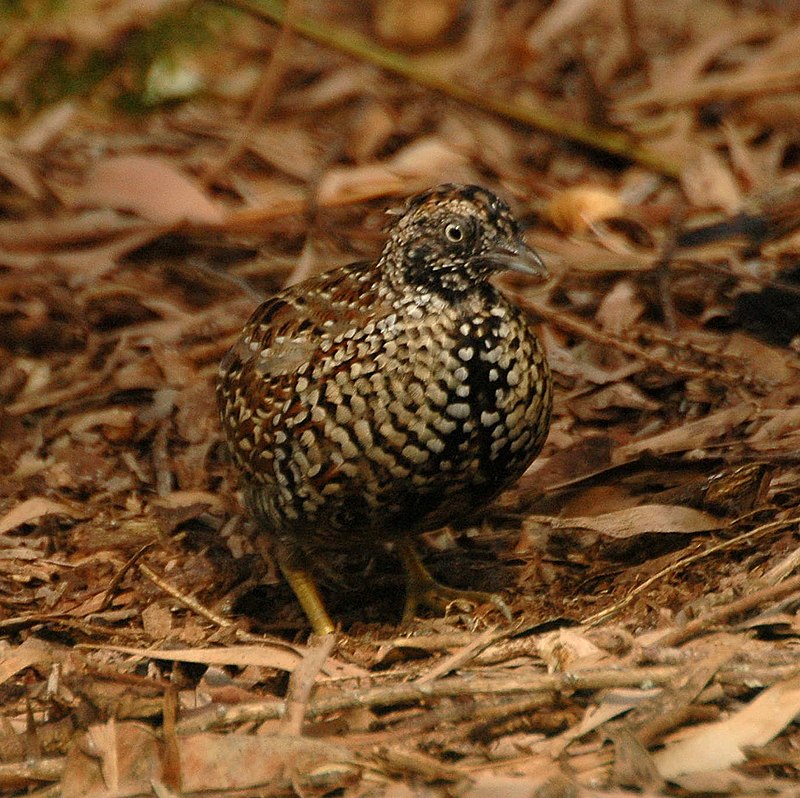
Buttonquails are small, terrestrial birds belonging to the family Turnicidae. They can be found in warm grasslands of Asia, Africa, Europe and Australia.
There are 18 species found across two genera; most being placed under the genus Turnix with a single species known as Ortyxelos.
These birds share a superficial resemblance to quail from Phasianidae but lack any close relation.
Buttonquails avoid flying and instead prefer running on their short legs for navigational purposes.
In terms of physicality they have drab colouring which comprises mostly browns or greys whilst sporting distinctive white patches around their eyes making them easy to identify within dense foliage areas where they usually hide away during times of danger or distress.Scientific classification:
| Kingdom | Animalia |
| Phylum | Chordata |
| Class | Aves |
| Order | Charadriiformes |
| Family | Turnicidae GR Gray, 1840 |
Also Featured In: Hong Kong Birds You Need to See, Birds of Karnataka
11. Monarch Flycatcher
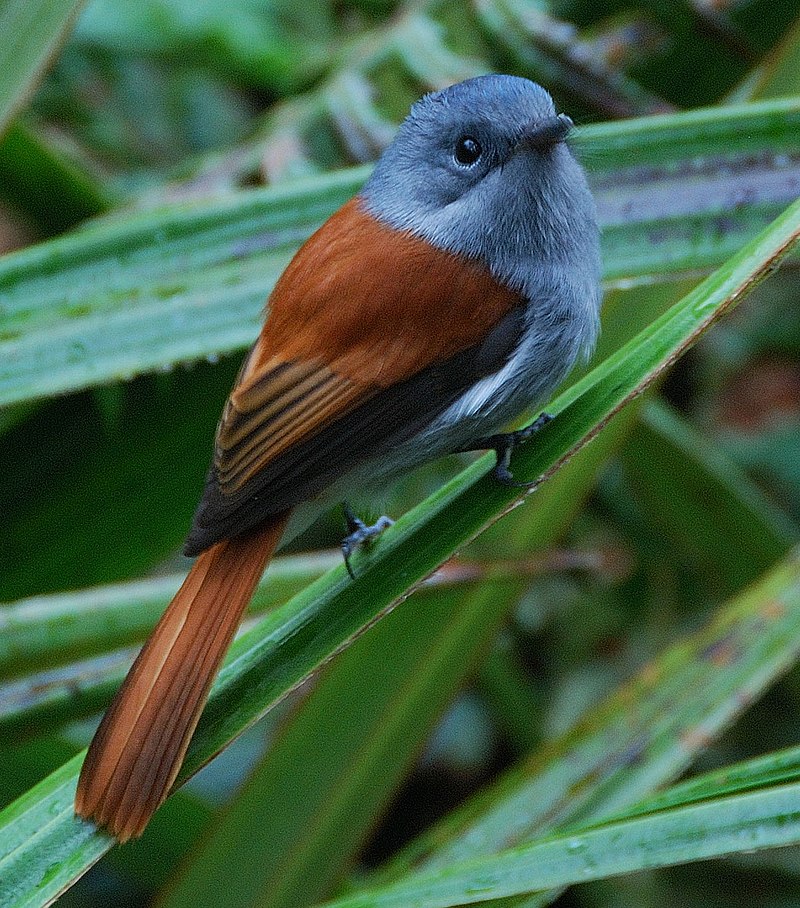
The Monarch flycatcher is a small passerine bird, belonging to the family Monarchidae. It inhabits forest or woodland areas across sub-Saharan Africa, south-east Asia, Australasia and various Pacific islands.
Only some species migrate seasonally. This beautiful little bird has a long tail and feeds mainly on insects it catches in its beak.
Its cup shaped nest can often be found hanging from branches high up in trees where they are safe from predators while incubating their eggs – usually between two to four of them at once.
The adult birds have attractive plumage with hues of blues and greens along with white patches near their tails which make for stunning displays when they take flight during mating season or migratory times.Scientific classification:
| Kingdom | Animalia |
| Phylum | Chordata |
| Class | Aves |
| Order | Passeriformes |
| Superfamily | Corvoidea |
| Family | Monarchidae Bonaparte, 1854 |
Also Featured In: Common Birds in Saudi Arabian,
12. Honeyeaters
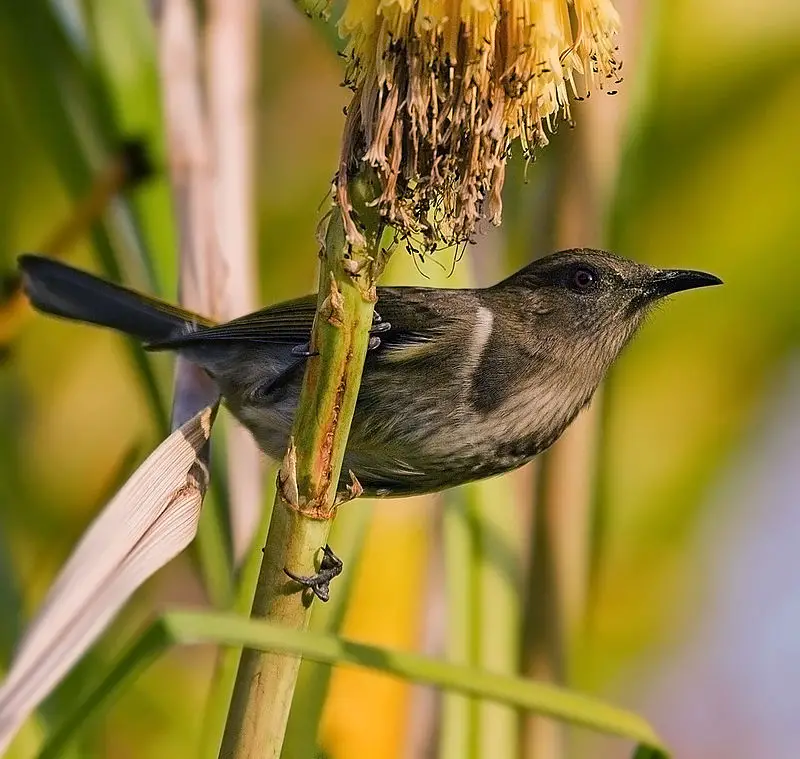
Honeyeaters are a unique and diverse family of birds, with species ranging in size from small to medium.
Found mainly in Australia and New Guinea, they can also be found as far east as Samoa and Tonga, or on islands such as Wallacea north or west of New Guinea.
Honeyeaters feed mainly on nectar but will consume insects if necessary for additional nutrition. They have specialized brush-like tongues that help them extract the nectar efficiently.
Their bright colours tend to make them stand out among other bird families making them easy to spot when out observing wildlife.Scientific classification:
| Kingdom | Animalia |
| Phylum | Chordata |
| Class | Aves |
| Order | Passeriformes |
| Superfamily | Meliphagoidea |
| Family | Meliphagidae Vigors, 1825 |
Also Featured In: Most common birds in Australia, Birds that Charles Darwin Studied
13. Superb Fairywren
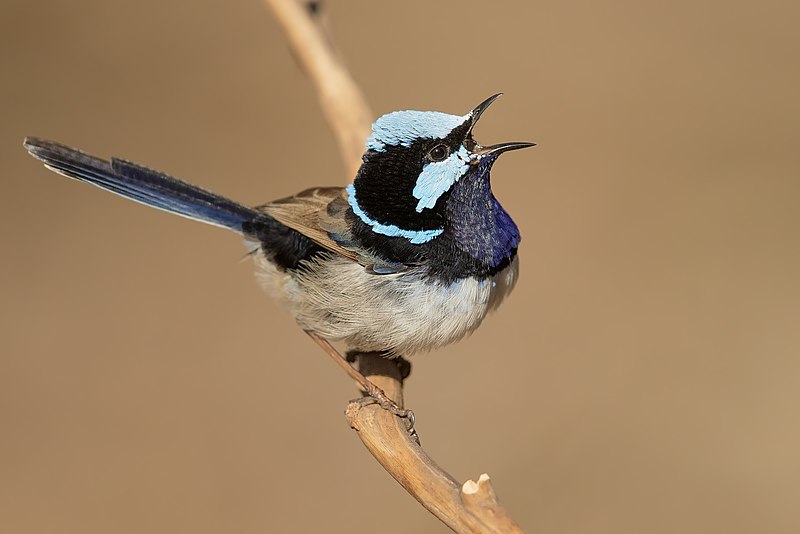
The Superb Fairywren is a beautiful and unique bird native to southeastern Australia.
The male in breeding plumage has an impressive bright blue forehead, ear coverts, mantle and tail with a black mask and either black or dark blue throat.
They are sedentary birds that form strong territorial bonds with their mates; the males staying close-by while the females build nests away from them.
These birds exhibit high sexual dimorphism; making it easy for us to distinguish between males and females of this species.
Their diet consists primarily of insects although they will also feed on other invertebrates as well as nectar, fruit and seeds when available.
This small passerine bird is sure to bring any garden alive with its vibrant colours.Scientific classification:
| Kingdom | Animalia |
| Phylum | Chordata |
| Class | Aves |
| Order | Passeriformes |
| Family | Maluridae |
| Genus | Malurus |
| Species | M. cyaneus |
14. Australian Pelican
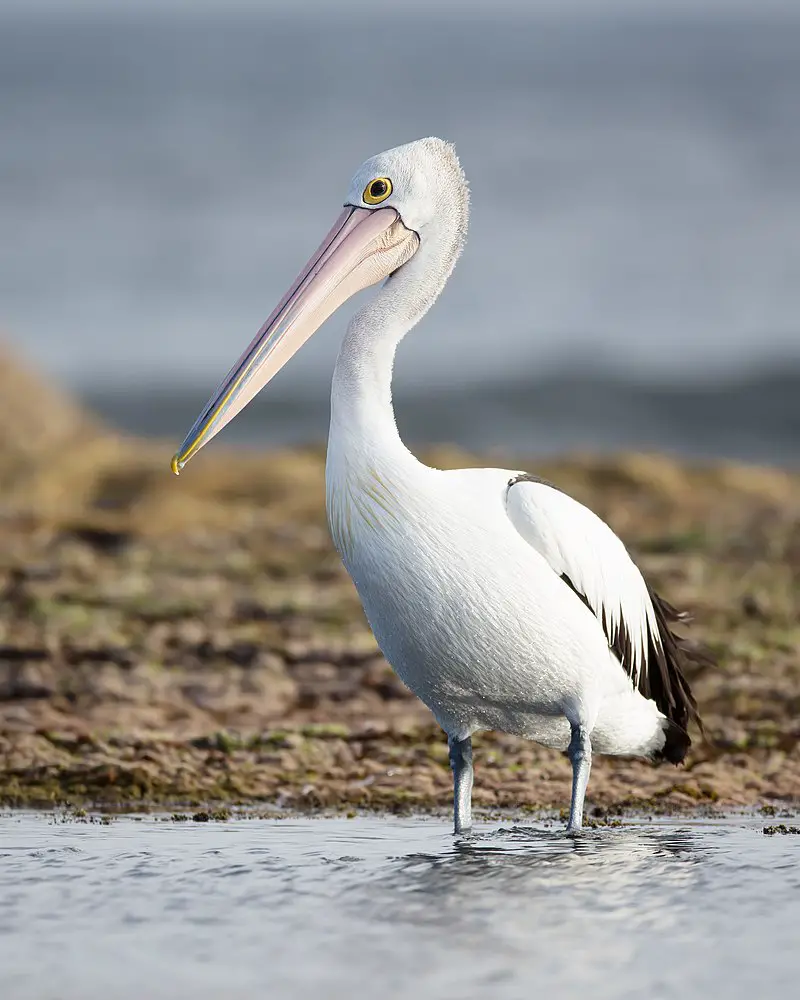
The Australian pelican is a majestic large waterbird with predominantly white plumage and black wings.
It has the longest bill of any living bird, which it uses to fish for its main source of food in both inland and coastal waters of Australia, New Guinea, Fiji, parts of Indonesia and as a vagrant in New Zealand.
They usually feed together by forming lines or circles around their prey before dipping down into the water at once.
In addition to fishing they also scavenge on other sources such as eggs from nesting seabirds or carrion.
Their unique appearance makes them an iconic species that can be easily recognised across many areas throughout Australasia making them popular amongst tourists who come to see them up close.Scientific classification:
| Kingdom | Animalia |
| Phylum | Chordata |
| Class | Aves |
| Order | Pelecaniformes |
| Family | Pelecanidae |
| Genus | Pelecanus |
| Species | P. conspicillatus |
Also Featured In: Birds of New Caledonia,
15. New Holland Honeyeater
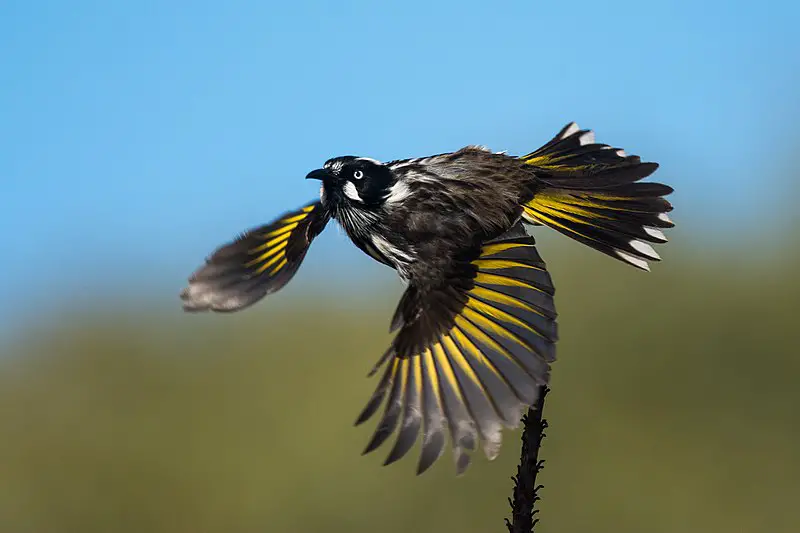
The New Holland honeyeater is a distinctive bird found in southern Australia. It has five subspecies and measures 18 cm long, with mainly black feathers contrasting against its white eyes.
This species was among the first to be scientifically described in Australia, known as Certhia novaehollandiae at that time.
These birds are very active and can often be seen searching for food or bathing on hot days near water sources such as streams or lakes.
They have an impressive range of vocalizations which they use to communicate with each other when looking for mates or defending their territories from intruders.
The New Holland Honeyeaters feed primarily on nectar but also consume insects, lizards, spiders and seeds when available throughout the year – making them essential pollinators within Australian ecosystems.Scientific classification:
| Kingdom | Animalia |
| Phylum | Chordata |
| Class | Aves |
| Order | Passeriformes |
| Family | Meliphagidae |
| Genus | Phylidonyris |
| Species | P. novaehollandiae |
16. Cuckooshrike
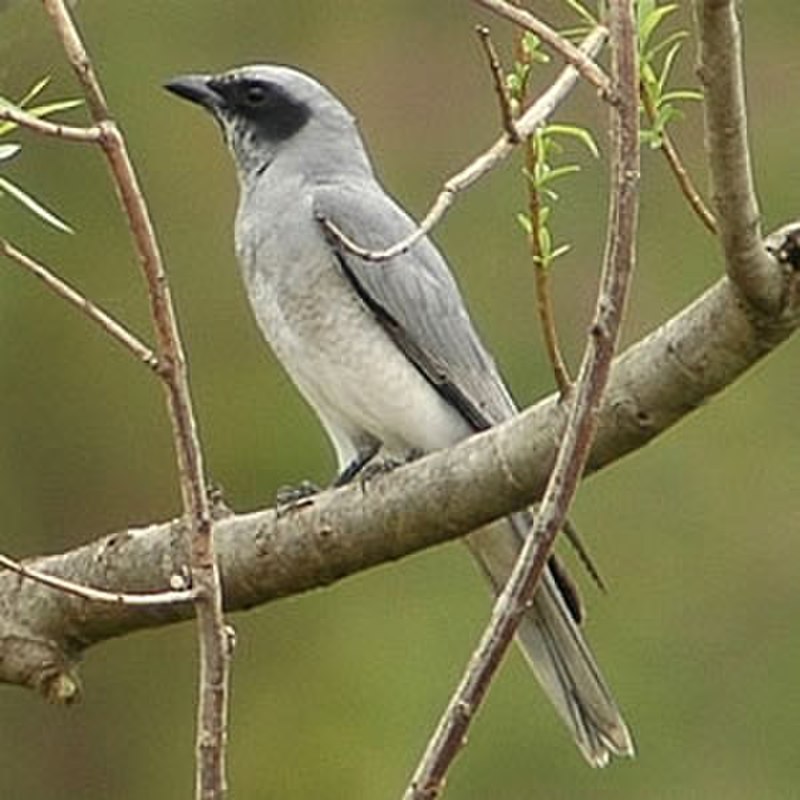
Cuckooshrikes are small to medium-sized passerine birds found mainly in the subtropical and tropical regions of Africa, Asia, and Australasia. They are usually arboreal, feeding on insects or fruit near foliage.
They have a stout bill with long wings and tails that can be used for balancing while perched on branches.
Cuckooshrike plumage is mostly grayish brown but some species may also feature black spots or stripes. The juvenile cuckooshrikes typically show more yellowish coloration than adults do.
These birds form monogamous pairs which often remain together year round defending their territory from other species as well as potential rivals within their own family group.Scientific classification:
| Kingdom | Animalia |
| Phylum | Chordata |
| Class | Aves |
| Order | Passeriformes |
| Infraorder | Corvides |
| Family | Campephagidae Vigors, 1825 |
Also Featured In: Top Birds of Rwanda,
17. Motacillidae
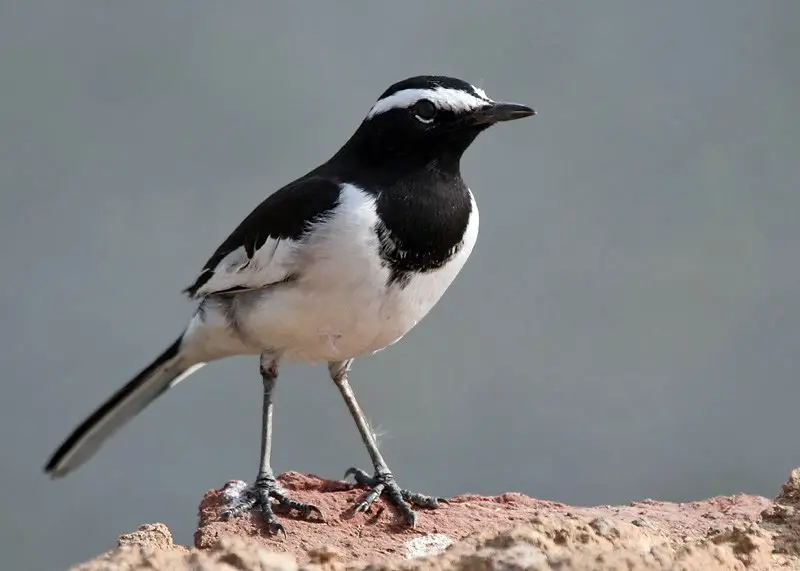
Motacillidae is a family of small passerine birds consisting of around 70 species. They are found across Europe, Africa, Asia and even Alaska with two migratory breeding species.
The three genera they belong to include wagtails which typically have medium to long tails; longclaws that can only be spotted in the Afrotropics; and pipits which possess the most cosmopolitan distribution worldwide.
These birds feed on insects as well as seeds for their diets and are usually seen in open habitats such grasslands or wetlands where food sources like invertebrates can easily be accessed.
Most Motacillidae species also use mud nests during breeding season making them easy targets for predators so it’s important we protect these beautiful creatures.Scientific classification:
| Kingdom | Animalia |
| Phylum | Chordata |
| Class | Aves |
| Order | Passeriformes |
| Superfamily | Passeroidea |
| Family | Motacillidae Horsfield, 1821 |
Also Featured In: Birds of Belgium, Belarus Birds You Should Know
18. Drongos
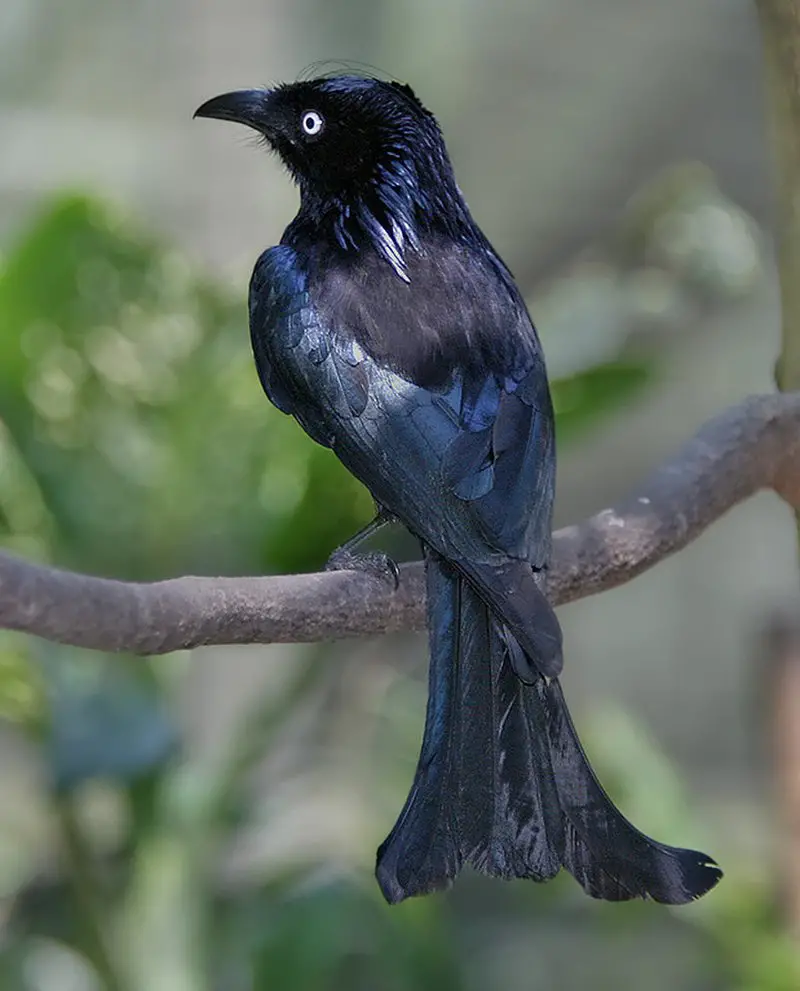
Drongos are an Old World tropical family of passerine birds belonging to the Dicruridae genus.
They have short legs, forked tails and a distinctive upright stance when perched.
Depending on the species they may be mostly black or dark grey in colour with some having elaborate tail decorations.
Drongos feed mainly on insects and small birds – catching them both in flight and from the ground.
They also sometimes eat fruit, nectar and even carcasses.
The drongo’s unique adaptations make it one of nature’s most successful hunters; able to survive almost anywhere in their natural range across Africa, Asia & Australia.Scientific classification:
| Kingdom | Animalia |
| Phylum | Chordata |
| Class | Aves |
| Order | Passeriformes |
| Superfamily | Corvoidea |
| Family | Dicruridae Vigors, 1825 |
| Genus | Dicrurus Vieillot, 1816 |
Also Featured In: Birds of United Arab Emirates, Savanna Birds You Need to See
19. Megapode
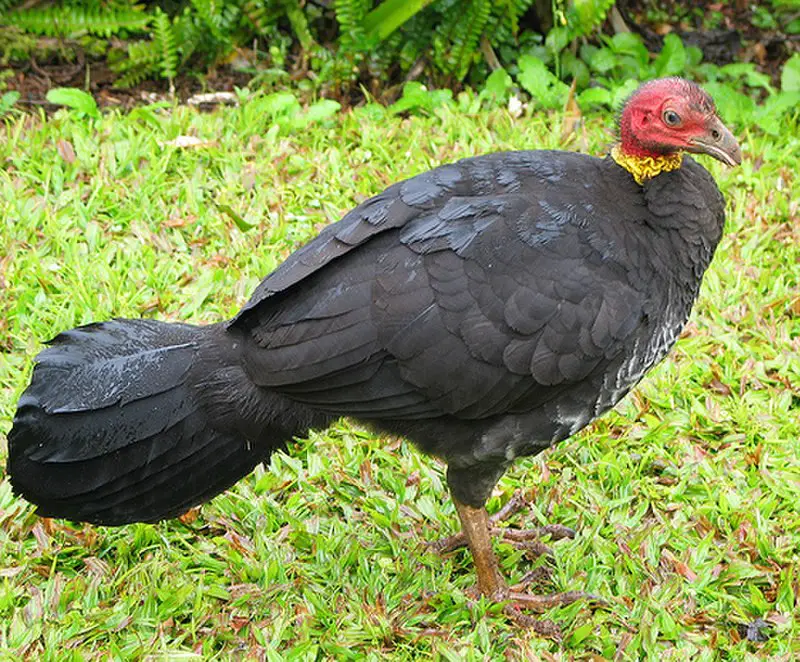
Megapodes are a unique family of birds with large feet and small heads. They measure from medium-large in size, similar to chickens, and have either brown or black feathers covering their bodies.
These terrestrial creatures live mainly in wooded areas where they browse for food like fruits and insects.
With the exception of the Malleefowl species, all Megapodes build mounds which act as incubators for them to lay eggs on – hence why they’re also known as “incubator birds”.
Thanks to this adaptation, these unusual animals can survive extreme temperatures by relying on heat generated from composting material beneath them instead of sitting directly atop their eggs.Scientific classification:
| Kingdom | Animalia |
| Phylum | Chordata |
| Class | Aves |
| Order | Galliformes |
| Family | Megapodiidae Lesson, 1831 |
Also Featured In: Papua New Guinea birds,
20. Cape Barren Goose
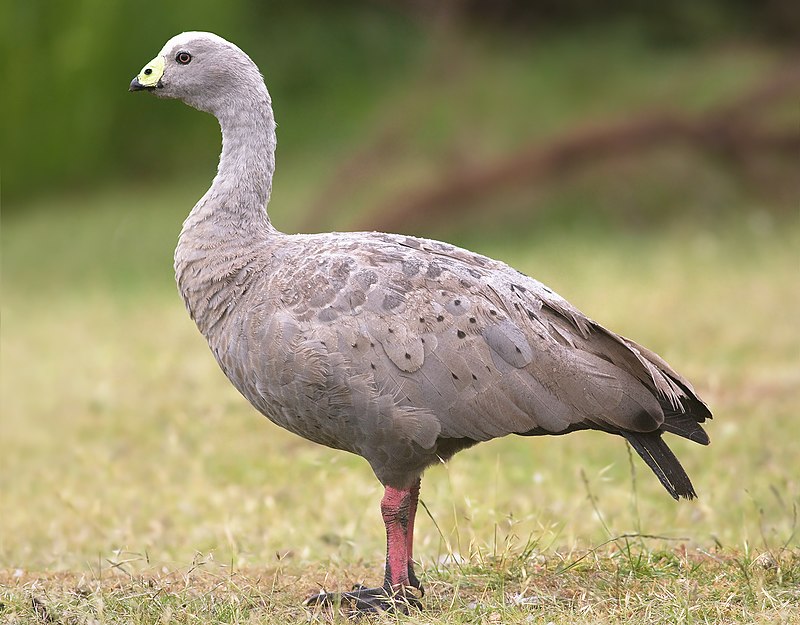
The Cape Barren goose is a large species of bird native to southern Australia. Its name derives from the Cape Barren Island, where it was first sighted by European explorers in 1801.
This goose belongs to the Jardwadjali language and is known as toolka there. It has an eye-catching plumage with greyish-brown feathers on its body and wings, while its head appears black or brownish.
The neck sports white stripes which look like arrowheads when seen up close, adding beauty to this majestic looking creature.
They feed mainly on grasses but also consume other vegetation such as seaweed and eelgrass during their migration season in summertime.
These geese are gregarious birds that live together in flocks for protection against predators.
To conclude, these magnificent creatures can be found all across southern Australian regions – making them truly one of nature’s wonders.Scientific classification:
| Kingdom | Animalia |
| Phylum | Chordata |
| Class | Aves |
| Order | Anseriformes |
| Family | Anatidae |
| Subfamily | Anserinae |
| Genus | Cereopsis Latham, 1801 |
| Species | C. novaehollandiae |
Also Featured In: New Zealand Birds,
21. Glossy Black Cockatoo
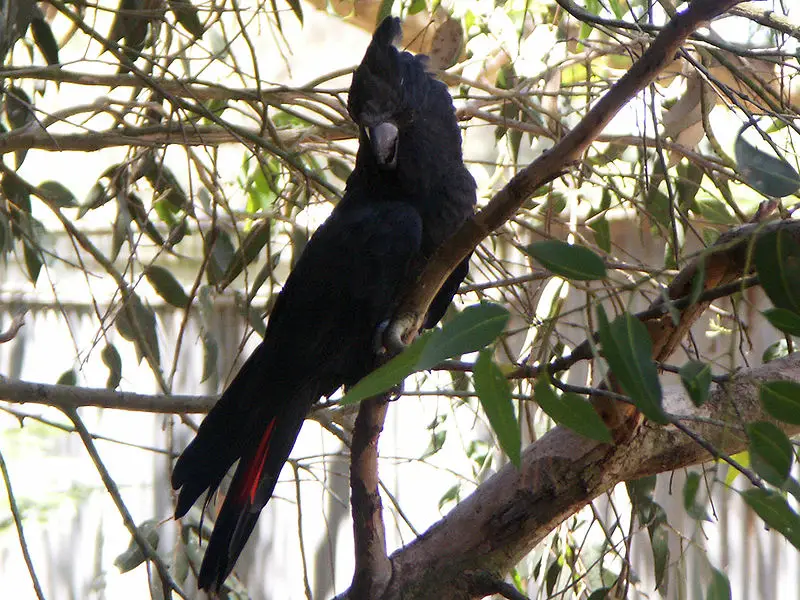
The Glossy Black Cockatoo is the smallest of its species and can be found in eastern Australia.
It has a length up to 50 cm, with males being blackish brown apart from their red tail bands, while females are dark-brown colored with some yellow spotting.
There are three recognized subspecies of this bird: Calyptorhynchus lathami lathami, C.l lroidoma and C.l semitorquatus.
They feed on seeds from native trees such as Eucalypts or Casuarinas but also forage for food near human settlements like farms or grasslands when natural resources become scarce during dry periods in summer time.
The male glossy black cockatoos have been known to make loud calls that echo through forests they inhabit which sound similar to machine gun fire.
Despite being listed as Near Threatened by IUCN Red List due to habitat destruction caused by logging activity, conservation efforts have been made aiming at preserving these magnificent birds so future generations can enjoy them too.Scientific classification:
| Kingdom | Animalia |
| Phylum | Chordata |
| Class | Aves |
| Order | Psittaciformes |
| Family | Cacatuidae |
| Genus | Calyptorhynchus |
| Species | C. lathami |
Also Featured In: Parrots Species, Queensland Birds You Should Know
22. Australian Pied Cormorant
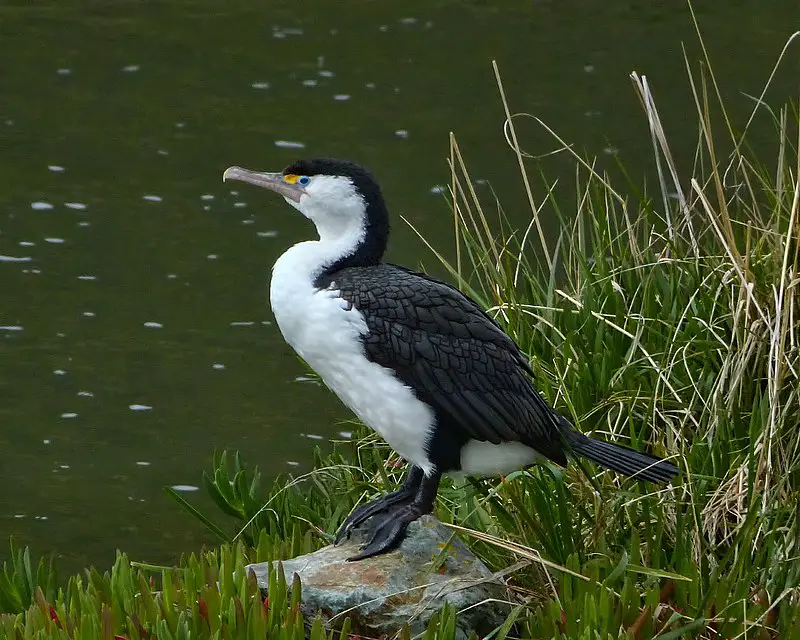
The Australian pied cormorant is a medium-sized member of the cormorant family and can be found around the coasts of Australasia.
It’s distinctive plumage features black feathers on its head, back, wings and tail with some white patches in between.
Its face has yellow skin that becomes bright orange when breeding season begins. The bird uses it’s webbed feet to swim through water searching for food such as fish or small crustaceans which make up most of their diet.
They often hunt by diving underwater from where they can stay submerged for about 30 seconds before resurfacing again for air.
During these dives they are able to travel depths up to 15 meters down.
This species also forms colonies when mating season comes around and will nest together in tall trees near shorelines or other bodies of water so that fishing is easier within reach during this time period every year.Scientific classification:
| Kingdom | Animalia |
| Phylum | Chordata |
| Class | Aves |
| Order | Suliformes |
| Family | Phalacrocoracidae |
| Genus | Phalacrocorax |
| Species | P. varius |
Also Featured In: Cormorant Species, Birds that Live around Victoria
23. Black-Faced Cormorant
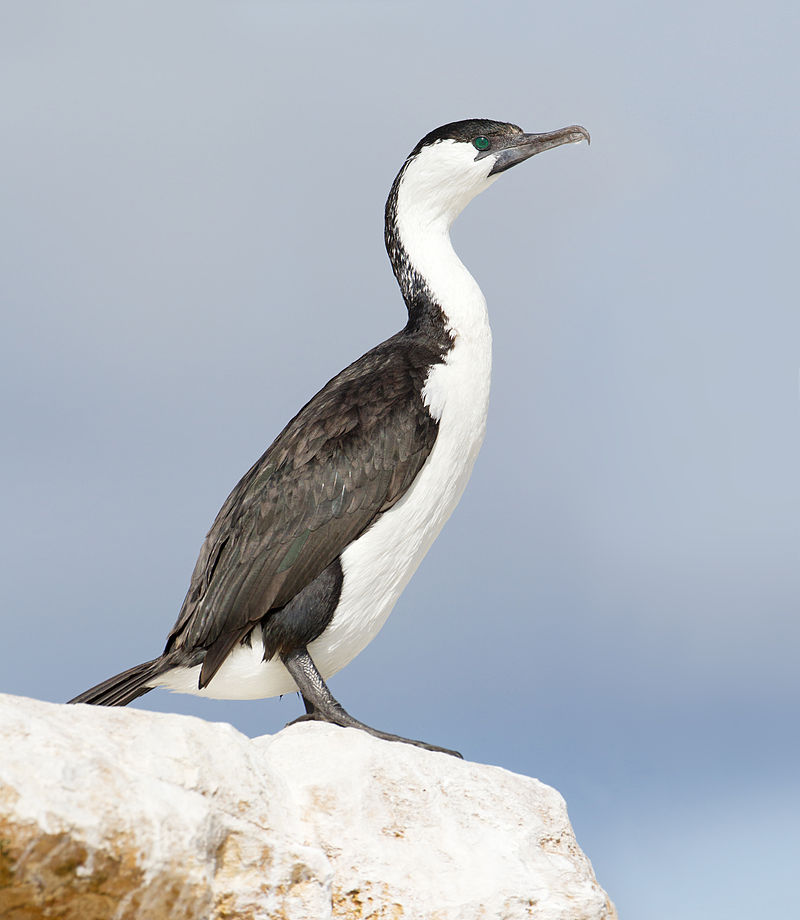
The Black-faced cormorant is a medium sized member of the cormorant family. It has an unmistakable black face, bill and upperparts which contrast wonderfully with its white underparts.
Endemic to coastal regions in southern Australia it can be seen aquatic bird roosting on rocky shores or perched atop trees near water bodies such as lakes, rivers and bays.
Its long hooked bill, webbed feet and powerful wings make it well adapted for diving underwater to hunt fish – their primary source of food.
With strong parental bonds they are often found nesting together in groups along cliffs or tree lined riverbanks helping each other raise their young ones until adulthood when they eventually leave the colony to fend for themselves.Scientific classification:
| Kingdom | Animalia |
| Phylum | Chordata |
| Class | Aves |
| Order | Suliformes |
| Family | Phalacrocoracidae |
| Genus | Phalacrocorax |
| Species | P. fuscescens |
Also Featured In: Birds of Tasmania, Common Flinders Island Birds
24. White-Fronted Tern
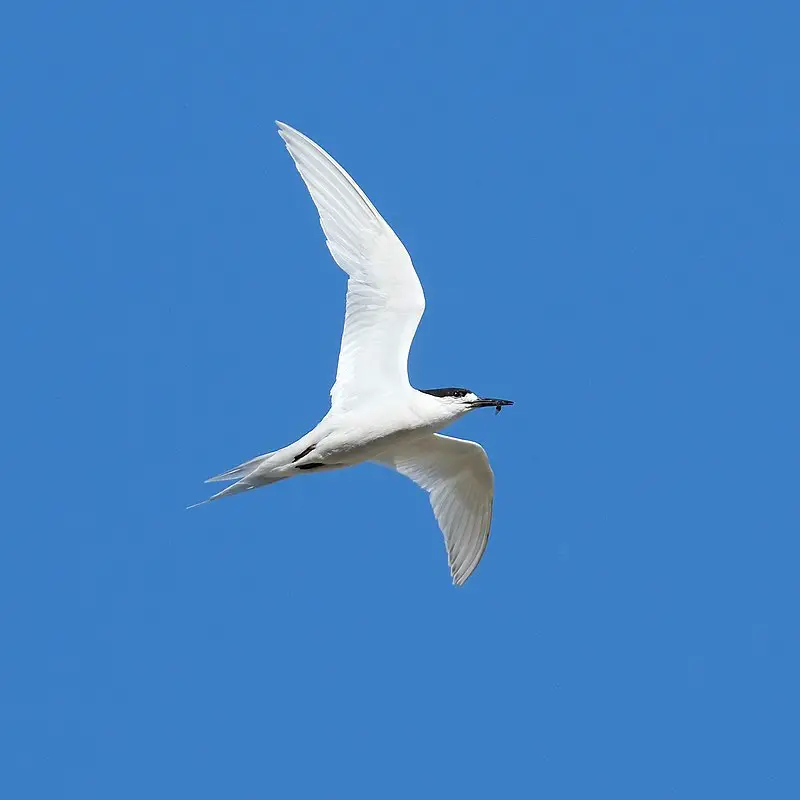
The White-fronted Tern is a medium-sized tern with an all white body and forked tail. Its wings have grey hues on the upper side and underwing.
During breeding season, this species can be distinguished by its striking black cap that covers its head, forehead and nape giving it a unique look.
It was first described by Johann Friedrich Gmelin in 1789 and goes by many names such as ‘tara’, ‘sea swallow’ or ‘swallowtail’.
These birds are commonly seen near coastlines where they hunt small prey like fish, crustaceans and insects over shallow waters.
Their diet also includes rodents which they capture during their migratory flights to more temperate regions during winter months.Scientific classification:
| Kingdom | Animalia |
| Phylum | Chordata |
| Class | Aves |
| Order | Charadriiformes |
| Family | Laridae |
| Genus | Sterna |
| Species | S. striata |
Also Featured In: Terns Species, Most Common Birds in Stewart Island
25. Flame Robin
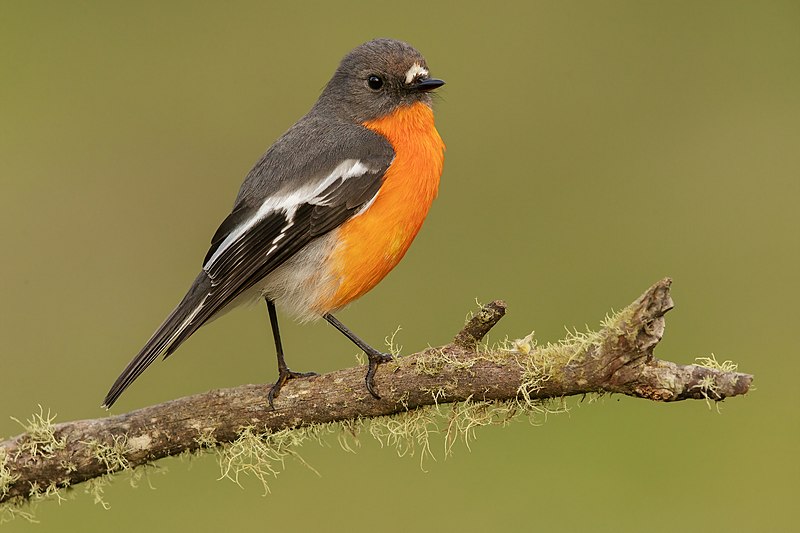
The Flame Robin is a small passerine bird native to Australia. It has bright red feathers on its chest and gets its name from the fiery coloring of these features.
This robin can be found in more excellent areas of south-eastern Australia, including Tasmania. While it’s not an uncommon sight, the Flame Robin isn’t particularly abundant either.
Its diet consists primarily of insects and other invertebrates which it finds while foraging through leaf litter or low vegetation. The species is sexually dimorphic with males having more vibrant plumage than females.
Nevertheless, both genders have striking colors that will catch any birdwatcher’s eye.Scientific classification:
| Kingdom | Animalia |
| Phylum | Chordata |
| Class | Aves |
| Order | Passeriformes |
| Family | Petroicidae |
| Genus | Petroica |
| Species | P. phoenicea |
Also Featured In: birds of orange, Birds of King Island
26. Striated Pardalote
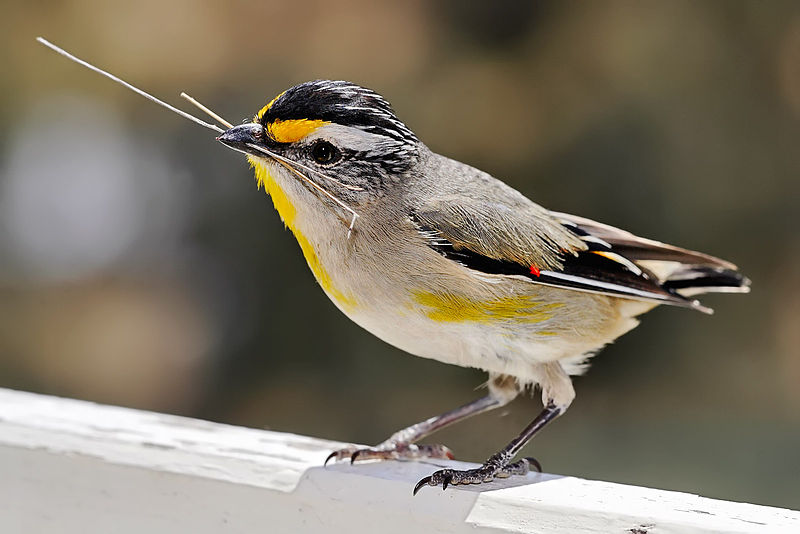
The Striated pardalote, also known as pickwick, wittachew or chip-chip, is a small, short-tailed bird. It is the most common and least colorful of the four pardalote species, and is frequently heard foraging in treetops for small creatures like lerps.
The Striated pardalote is more often heard than seen due to its inconspicuous appearance. Four distinct species of the pardalote were initially identified, but the Striated pardalote can be recognized by its physical characteristics.
Despite its lack of dazzling colors, this bird is a beloved sight for birdwatchers, and contributes to the biodiversity of the local ecosystem.Scientific classification:
| Kingdom | Animalia |
| Phylum | Chordata |
| Class | Aves |
| Order | Passeriformes |
| Family | Pardalotidae |
| Genus | Pardalotus |
| Species | P. striatus |
Also Featured In: Birds that Live around Brisbane, Birds that Live in Sunshine Coast
27. Fantails
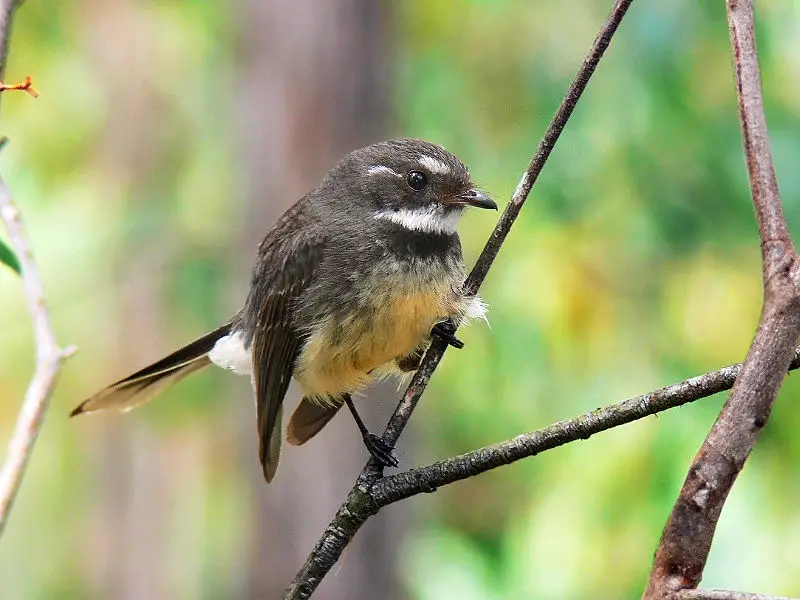
Fantails are small, insectivorous birds that belong to the family Rhipiduridae. They are found in the Australasia, Southeast Asia, and Indian subcontinent.
These birds are known for their distinctive long tails that fan out beautifully when they are in flight. Fantails are agile and skilled fliers, thanks to their broad wings and lightweight bodies.
They feed mainly on insects that they catch mid-air with their sharp beaks. Fantails are social birds and are often seen in pairs or flocks.
They are curious and friendly and are known to approach humans with ease.
Some species of fantails are known for their vocalizations and can often be heard singing sweet melodies.
Overall, fantails are delightful birds to observe and are a valuable part of their ecosystem.Scientific classification:
| Kingdom | Animalia |
| Phylum | Chordata |
| Class | Aves |
| Order | Passeriformes |
| Superfamily | Corvoidea |
| Family | Rhipiduridae Sundevall, 1872 |
Also Featured In: Guam Birds You Need to See, Most Common Taiwan Birds
28. Hooded Dotterel
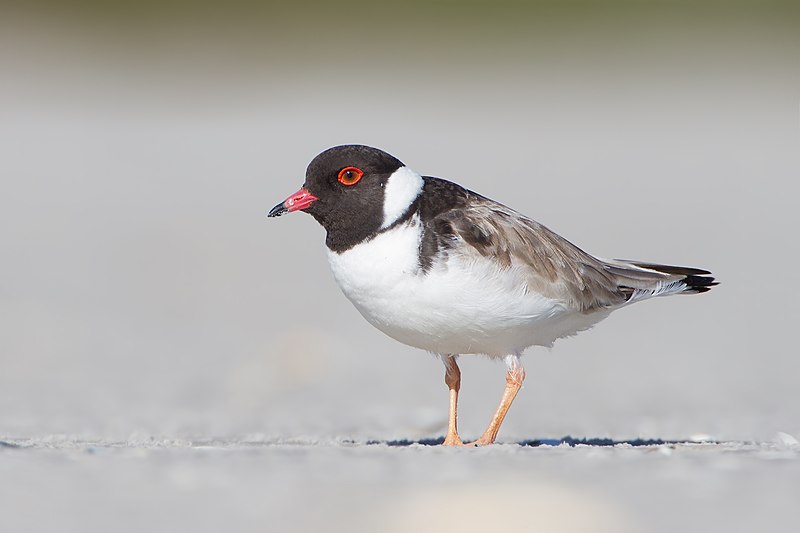
The Hooded Dotterel is a bird species that belongs to the Charadriidae family. It can be found exclusively in southern Australia, mostly inhabiting ocean beaches and subcoastal lagoons.
This bird species has two identified subspecies, with distinct populations in the east and west.
The eastern subspecies is particularly vulnerable, with different listings according to conservation organizations.
The Hooded Dotterel is also called the Hooded Plover, and it is a small bird with a distinct appearance.
Despite being a beach bird, it is not a strong swimmer and relies on its long, thin legs to move quickly on the sand.
Sadly, this bird species is threatened by human activities, such as off-road vehicles and unleashed dogs, and habitat destruction due to coastal development.
Therefore, conservation efforts are essential to protect this unique and important bird species.Scientific classification:
| Kingdom | Animalia |
| Phylum | Chordata |
| Class | Aves |
| Order | Charadriiformes |
| Family | Charadriidae |
| Genus | Thinornis |
| Species | T. cucullatus |
Also Featured In: Birds that Live Near Adelaide, South Australian Birds
29. Little Penguin
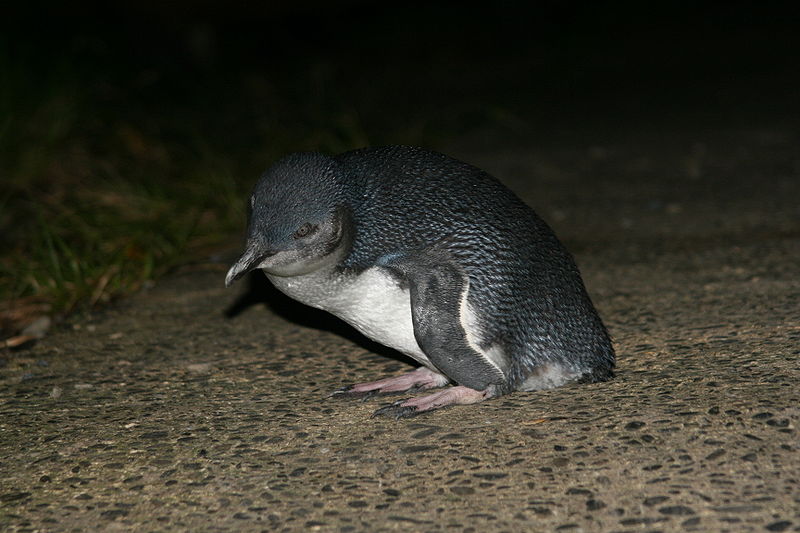
The Little Penguin, also known as the Blue Penguin or Kororā in Māori, is a type of penguin found in New Zealand. With its distinctive slate-blue plumage, it is a beloved symbol of the island nation’s wildlife.
The Little Penguin is a small bird that stands no taller than 40cm and weighs a mere 1kg, making it the smallest species of penguin in the world.
It can be found in many coastal and offshore areas around New Zealand, and is also known to frequent parts of Australia.
In fact, there is such a strong connection between New Zealand and this dapper little bird that it is often used as the mascot for local sports teams and other cultural events.
Despite its diminutive size, the Little Penguin is a tough survivor that has adapted well to the challenges of life in the wild.Scientific classification:
| Kingdom | Animalia |
| Phylum | Chordata |
| Class | Aves |
| Order | Sphenisciformes |
| Family | Spheniscidae |
| Genus | Eudyptula |
| Species | E. minor |
Also Featured In: Common Melbourne Birds, Birds You’ll Find in Night
30. Brown Thornbill
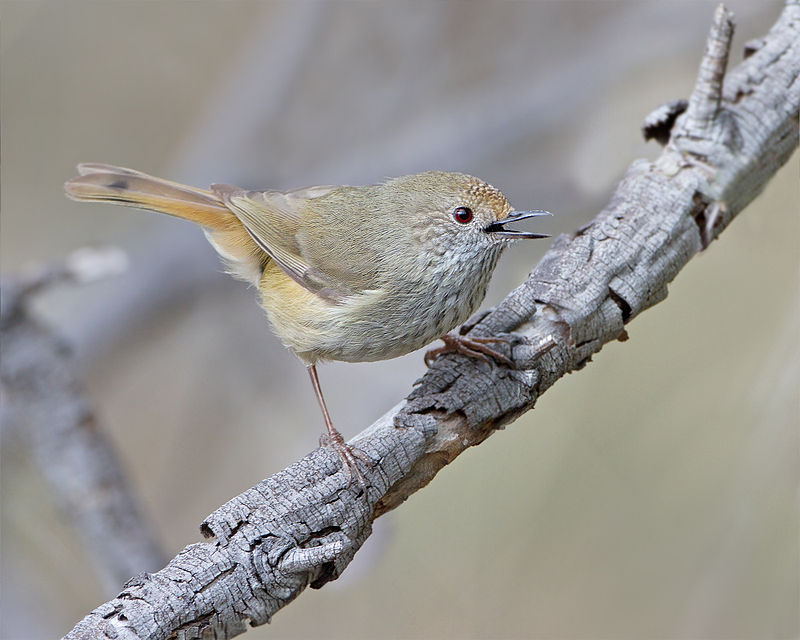
The Brown thornbill is a small bird native to eastern and south-eastern Australia, including Tasmania. With a maximum length of 10 cm, the bird is predominantly brown, gray, and white in appearance.
It belongs to the order Passeriformes and the family Acanthizidae, with the species consisting of five different subspecies. The bird’s diet mainly includes insects.
Its habitat includes various forest types, woodlands, and heaths, where it prefers to inhabit the lower layers of vegetation.
The Brown thornbill is known to be a skillful forager, and it generally feeds on insects found on the bark and leaves of trees.
The bird’s beautiful plumage and melodious chirping make it a popular species amongst birdwatchers and nature enthusiasts.Scientific classification:
| Kingdom | Animalia |
| Phylum | Chordata |
| Class | Aves |
| Order | Passeriformes |
| Family | Acanthizidae |
| Genus | Acanthiza |
| Species | A. pusilla |
Also Featured In: New South Wales Birds You Need to See, Small Birds that Live in New South Wales
31. Little Wattlebird
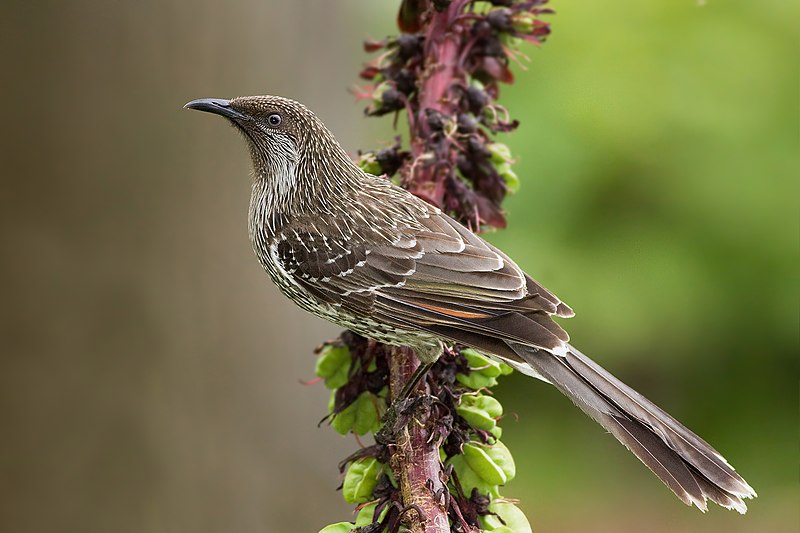
The Little Wattlebird, commonly known as the brush wattlebird, belongs to the Meliphagidae family of passerine birds.
These birds are primarily found in coastal and sub-coastal southeastern Australia.
Ornithologist John Latham described the species for the first time in 1801, under the name Merops chrysoptera.
Today, the Little Wattlebird is categorized under the Anthochaera genus. Although small, these birds possess a distinct wattled appearance and a brush-like tail.
Little Wattlebirds are known for their complex songs, consisting of various clicks, whistles, and harsh calls.
They feed on insects, nectar, fruit, and pollen, using their long, curved beaks to extract nectar.
These birds are known to be territorial and active communicators, making them a fascinating species to observe in their natural habitat.Scientific classification:
| Kingdom | Animalia |
| Phylum | Chordata |
| Class | Aves |
| Order | Passeriformes |
| Family | Meliphagidae |
| Genus | Anthochaera |
| Species | A. chrysoptera |
Also Featured In: Sydney Birds You Need to See,
32. Purple-Gaped Honeyeater
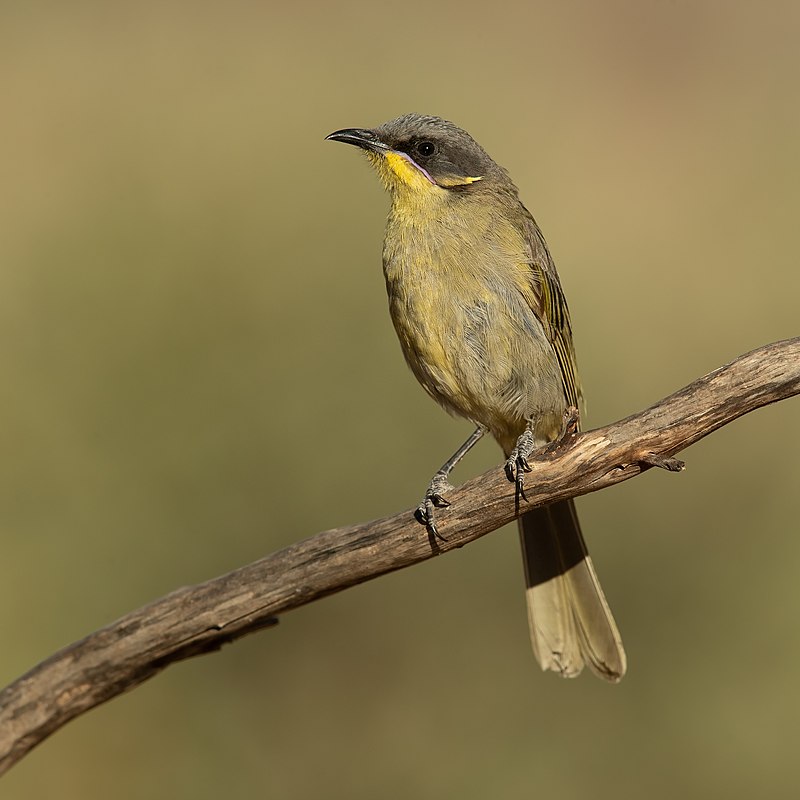
The Purple-gaped honeyeater is a bird species found in southern Australia. It lives in mallee, tall heath, and low eucalypt woodland areas.
The bird is medium-sized, and its body is generally grey-olive above and buffish yellow below.
Its head is patterned. The bird’s name is derived from the purple coloration in its gape, which is the inside of its mouth.
This species is part of the Meliphagidae family, and it is known for feeding mainly on nectar, insects, and pollen.
The Purple-gaped honeyeater is endemic to Australia, meaning it is only found there. Its natural habitat is under threat due to habitat destruction, and the bird’s populations are decreasing.Scientific classification:
| Kingdom | Animalia |
| Phylum | Chordata |
| Class | Aves |
| Order | Passeriformes |
| Family | Meliphagidae |
| Genus | Lichenostomus |
| Species | L. cratitius |
Also Featured In: Most Common Western Australia Birds,
33. Scarlet Robin
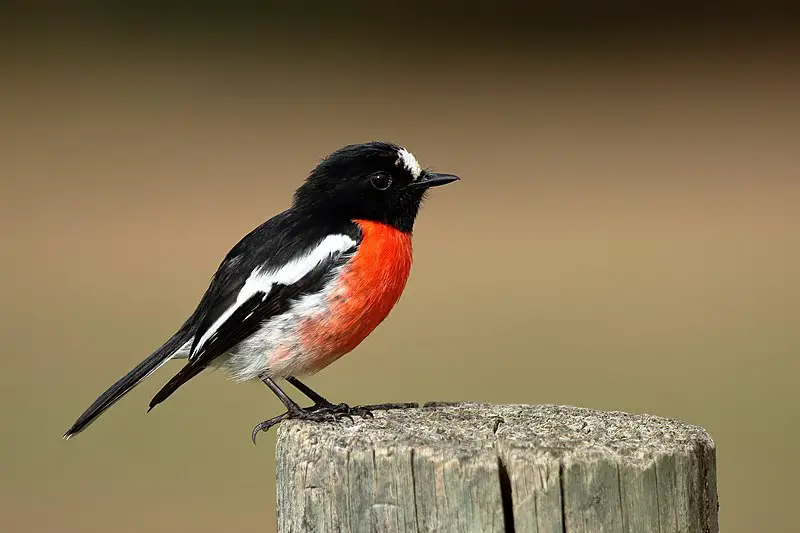
The Scarlet Robin is a red-breasted bird belonging to the Petroica genus. It can be commonly found in Australia and its surrounding islands, such as Tasmania.
Originally identified by Gmelin in Norfolk Island, the species was later split by Schodde and Mason in 1999.
The Scarlet Robin is a passerine bird, meaning it has a unique and specialized mode of feeding.
It is often seen foraging for food on the ground or in lower vegetation. This bird is quite active, and its red plumage makes it easy to spot. Its cheerful tunes also make it a favored bird among birdwatchers.
In addition, the Scarlet Robin has played an essential role in Australia’s indigenous culture, with several myths and stories revolving around it.Scientific classification:
| Kingdom | Animalia |
| Phylum | Chordata |
| Class | Aves |
| Order | Passeriformes |
| Family | Petroicidae |
| Genus | Petroica |
| Species | P. boodang |
34. Striated Thornbill
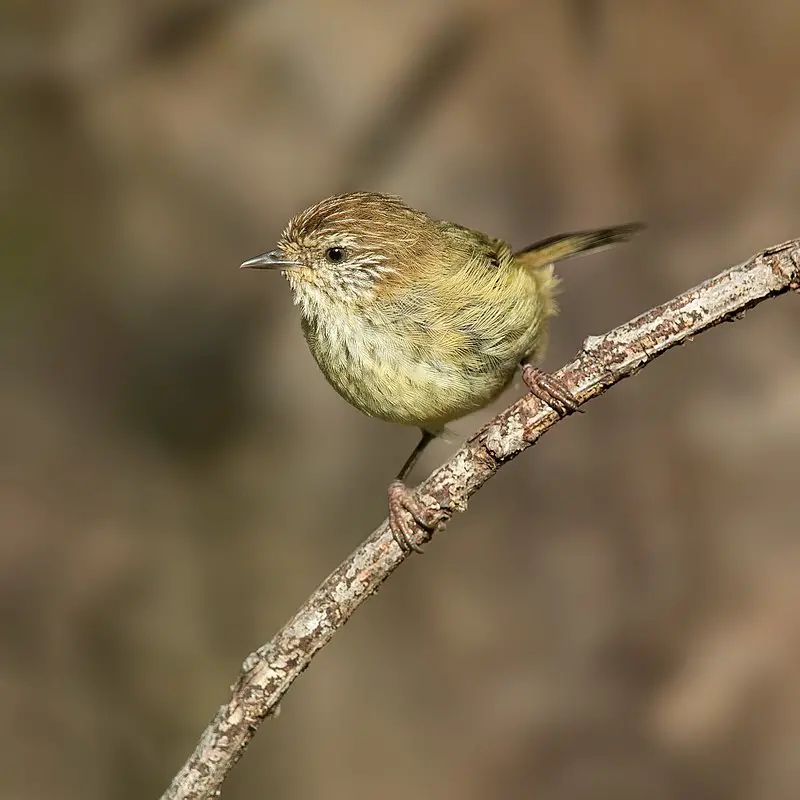
The Striated thornbill is a bird species found only in Australia. Its natural habitat is subtropical or tropical dry forests.
These birds have been given several common names such as striped-crowned thornbill or tit-warbler, and striated tit-warbler or tit.
They are small in size and belong to the family Acanthizidae. John Gould described these birds in 1838 and the scientific name is Acanthiza lineata.
The Striated thornbill has a striped pattern on its head and a sharp bill adapted for feeding on insects. They have a high-pitched and melodious call.
These birds are often seen in pairs or small groups and play an important role in the ecosystem by acting as pollinators and insect controllers. They are a beautiful addition to the biodiversity of Australia.Scientific classification:
| Kingdom | Animalia |
| Phylum | Chordata |
| Class | Aves |
| Order | Passeriformes |
| Family | Acanthizidae |
| Genus | Acanthiza |
| Species | A. lineata |
35. Musk Lorikeet
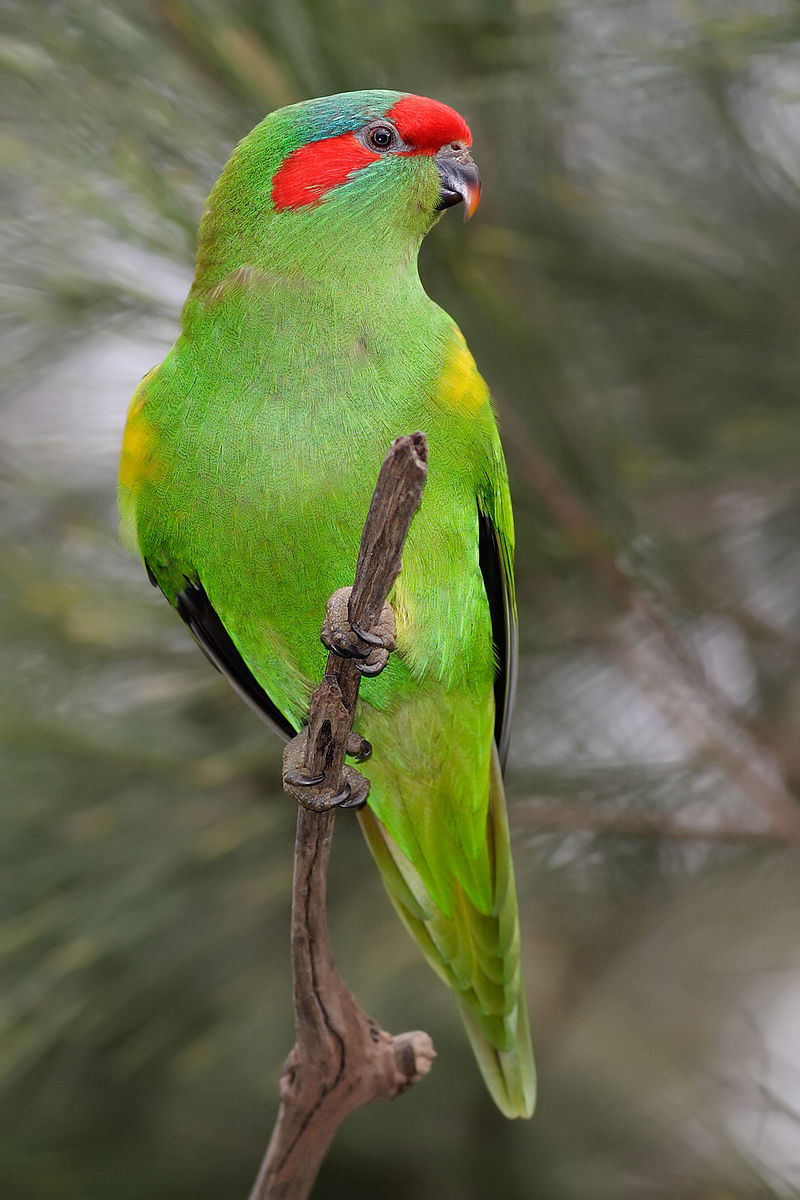
The musk lorikeet is a species of lorikeet found in south-central and eastern Australia. It is the only species in the genus Glossopsitta. The little lorikeet and purple-crowned lorikeet were once classified in the same genus.
First described by ornithologist George Shaw in 1790, the musk lorikeet resides in the Port Jackson vicinity.
It is a small bird with a distinct green plumage and a red face, as well as a pointed tail. Its diet consists mainly of nectar and pollen.
The species is known for its distinct call, which can be heard in flight or when the birds are gathered together.
The musk lorikeet tends to form large communal groups and can often be seen flying in flocks.Scientific classification:
| Kingdom | Animalia |
| Phylum | Chordata |
| Class | Aves |
| Order | Psittaciformes |
| Family | Psittaculidae |
| Tribe | Loriini |
| Genus | Glossopsitta Bonaparte, 1854 |
| Species | G. concinna |
36. Grey Currawong
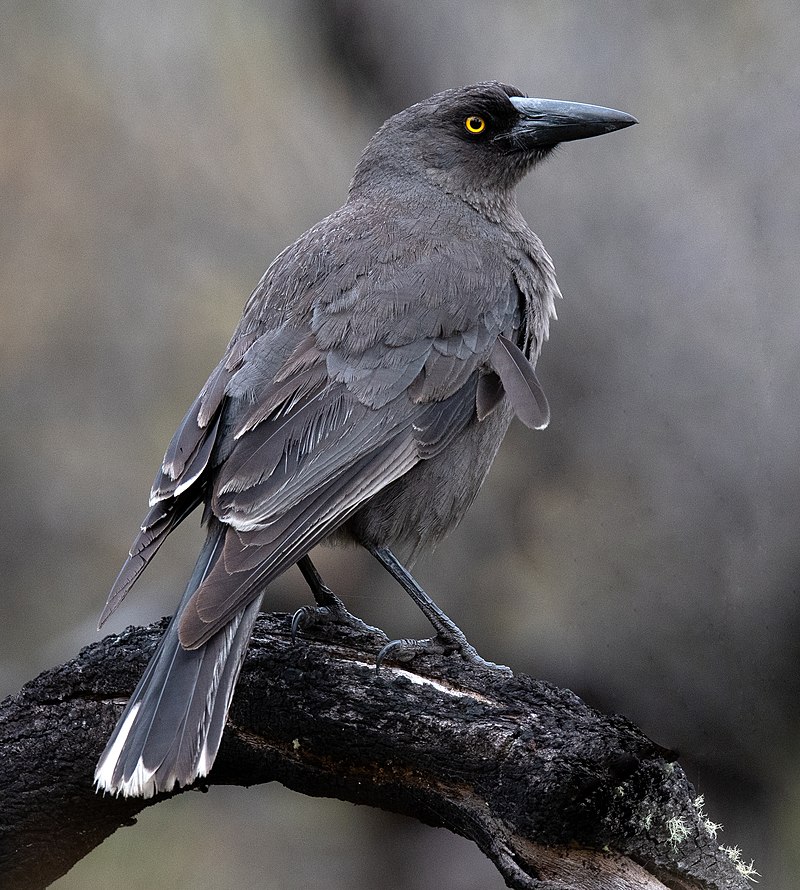
The Grey currawong is a bird that belongs to the Strepera genus and is widely found in southern Australia, along with Tasmania.
This sizeable passerine bird, measuring an average of 48 cm, is similar to a crow with a heavy bill, dark plumage, and a white undertail.
Interestingly, this bird has yellow irises that further enhance its striking appearance.
The Grey currawong is one of the three currawong species and has close relations with the Australian magpie and butcherbirds belonging to the Artamidae family.
Despite its size and crow-like appearance, this bird is widely found in Australia, and its recognizable call is a familiar sound to many Australians.
Overall, this distinctive bird is a sight to behold and an essential part of Australia’s diverse birdlife.Scientific classification:
| Kingdom | Animalia |
| Phylum | Chordata |
| Class | Aves |
| Order | Passeriformes |
| Family | Artamidae |
| Genus | Strepera |
| Species | S. versicolor |
37. Southern Emu-Wren
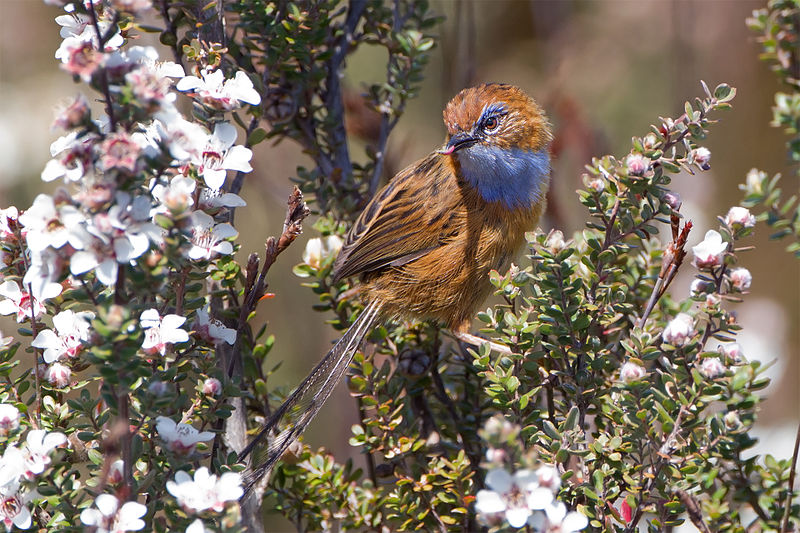
The Southern emu-wren bird is an Australian species found in temperate forests, Mediterranean-type shrubby vegetation, and swamplands.
This small bird belongs to the Maluridae family and is known for its distinctive appearance.
The male has rusty-brown upper parts with streaks of black and a reddish crown. Its wings are grey-brown, and its throat, upper chest, and eyes are a beautiful sky-blue.
However, this stunning bird is unfortunately considered to be a vulnerable species due to habitat loss and degradation caused by human activities.
Conservation efforts are underway to protect the Southern emu-wren and ensure its survival for future generations to enjoy.Scientific classification:
| Kingdom | Animalia |
| Phylum | Chordata |
| Class | Aves |
| Order | Passeriformes |
| Family | Maluridae |
| Genus | Stipiturus |
| Species | S. malachurus |
38. Pachycephalidae
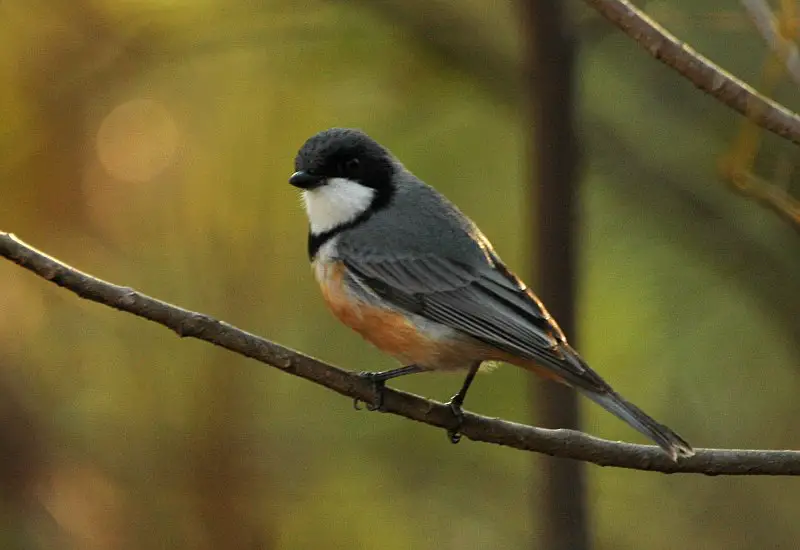
Pachycephalidae is a family of songbirds including whistlers, shrikethrushes and certain pitohuis. There are 64 species distributed across five genera that vary in size and are predominantly found across Australasia.
These birds are part of an ancient Australo-Papuan radiation of songbirds. Australia and New Guinea are the primary centres of their diversity.Scientific classification:
| Kingdom | Animalia |
| Phylum | Chordata |
| Class | Aves |
| Order | Passeriformes |
| Superfamily | Orioloidea |
| Family | Pachycephalidae Swainson, 1832 |
39. Rock Parrot
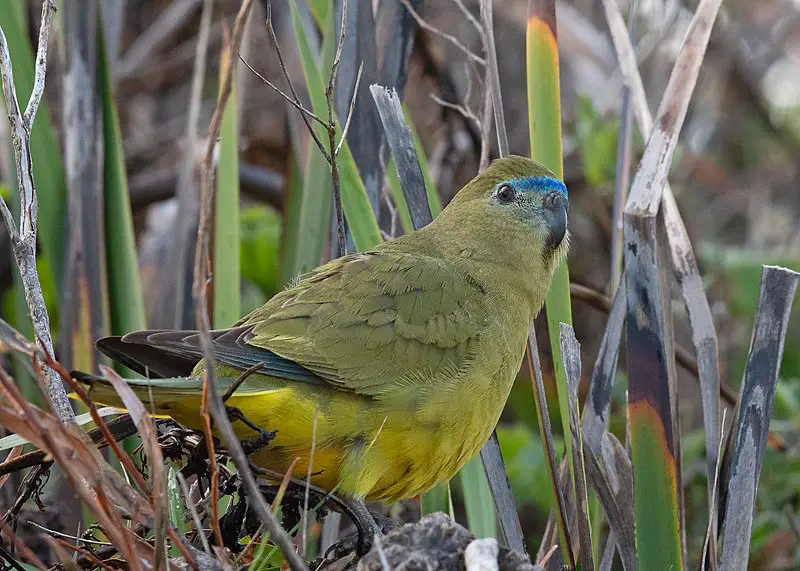
The Rock parrot is a small bird native to Australia. It was described by John Gould in 1841. This parrot is primarily olive-brown with yellowish underparts.
Its head features light blue forecheeks, lores, and a dark blue frontal band line across the crown. The Rock parrot is about 22 to 24 cm long and weighs between 50 and 60 g.Scientific classification:
| Kingdom | Animalia |
| Phylum | Chordata |
| Class | Aves |
| Order | Psittaciformes |
| Family | Psittaculidae |
| Genus | Neophema |
| Species | N. petrophila |
40. Elegant Parrot
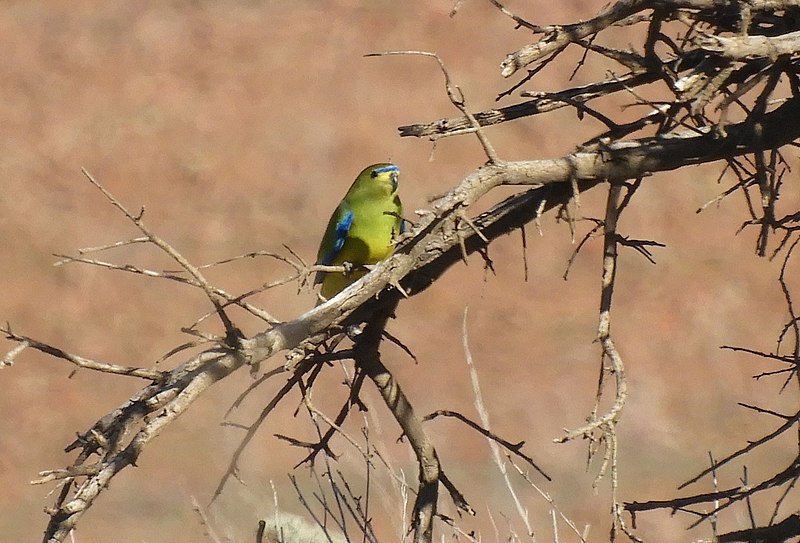
The Elegant Parrot is a beautiful species of parrot found only in Australia. It belongs to the Psittaculidae family and is commonly known as Neophema elegans.
The parrot was given its name by John Gould, a famous ornithologist and artist, in 1837. The species name comes from the Latin word “elegant,” which perfectly describes the bird’s graceful appearance.
Aboriginal peoples referred to it as carteri, bilgir, or koolyederong. The Elegant Parrot is one of six species of grass parrot in the Neophema genus.
Its striking colors, including a bright blue head and wings, make it a popular bird for aviculture.
However, the Elegant Parrot is still considered vulnerable in the wild due to habitat destruction and other threats.Scientific classification:
| Kingdom | Animalia |
| Phylum | Chordata |
| Class | Aves |
| Order | Psittaciformes |
| Family | Psittaculidae |
| Genus | Neophema |
| Species | N. elegans |
Also Featured In: Birds that You’ll find in Perth,
41. Pardalote
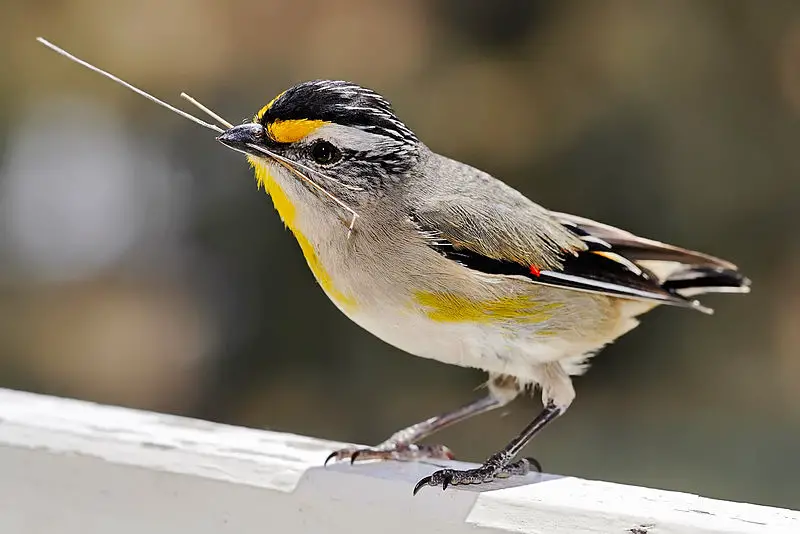
The Pardalote is a tiny bird native to Australia. It has a bright and colorful appearance, a strong build with short tails, and a blunt beak.
This bird is part of the Pardalotidae family, which includes four different species under the Genus Pardalotus.
The name of this bird comes from the Greek word “spotted”. The Pardalote’s family once had other species, which are now part of the Acanthizidae family.Scientific classification:
| Kingdom | Animalia |
| Phylum | Chordata |
| Class | Aves |
| Order | Passeriformes |
| Superfamily | Meliphagoidea |
| Family | Pardalotidae Strickland, 1842 |
| Genus | Pardalotus Vieillot, 1816 |
42. Grey Shrikethrush
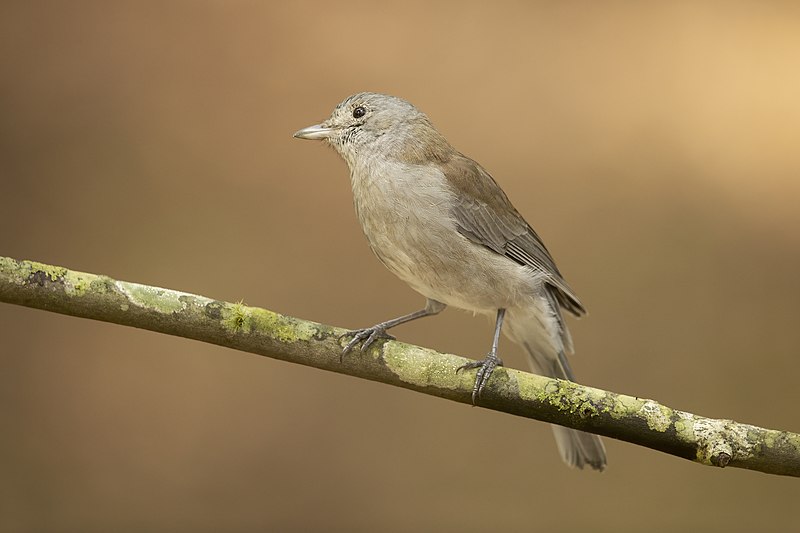
The grey shrikethrush, also known as the grey shrike-thrush or grey thrush, is a songbird native to Australasia. It can be found in most parts of Australia, but is absent from the driest areas of the inland deserts.
The bird is moderately common and is also found in New Guinea. It was originally classified under the genus Turdus.
The grey shrikethrush is often mistaken for the brown shrike-thrush due to similar appearance. They have a unique vocalization that consists of a series of melodious notes.
This bird is territorial and can be heard singing throughout the year, with peak breeding season being in August to December.
Despite being a common bird, certain regional populations have declined due to habitat destruction and fragmentation.Scientific classification:
| Kingdom | Animalia |
| Phylum | Chordata |
| Class | Aves |
| Order | Passeriformes |
| Family | Pachycephalidae |
| Genus | Colluricincla |
| Species | C. harmonica |
Also Featured In: Native Birds Of Mackay,
43. Yellow-Billed Spoonbill
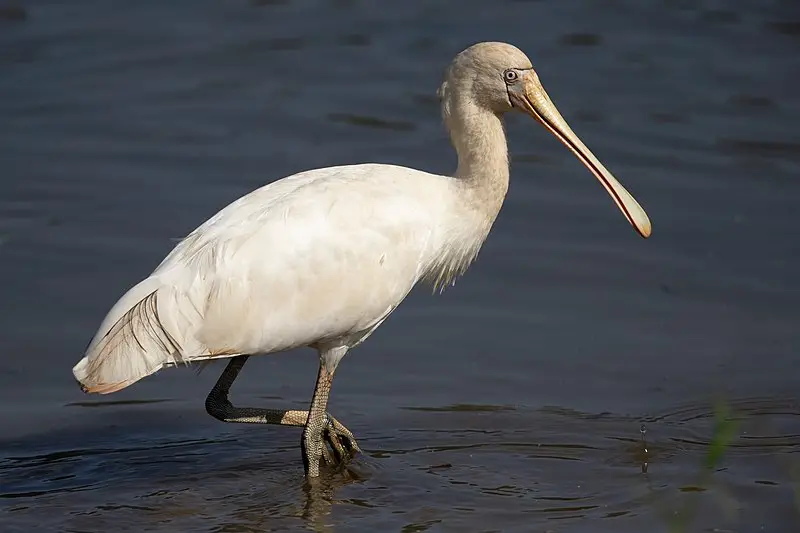
The yellow-billed spoonbill is a social bird belonging to the ibis and spoonbill family. It is found natively in Australia, with occasional sightings in New Zealand, Norfolk Island, and Lord Howe Island.
Its distinctness from other members of its genus was noted by ornithologist John Gould, who called it Platalea flavipes. With its distinctive yellow-tipped bill, it is easily recognizable.
The yellow-billed spoonbill primarily feeds on small aquatic creatures, using its bill like a spoon to scoop up food from the water.
It is also known for its striking white plumage, which contrasts with the black feathers on its wings. As a gregarious species, it is known for congregating in groups, especially during breeding season.
Despite its vulnerable status due to habitat loss and hunting pressures, conservation efforts are in place to protect this unique bird.Scientific classification:
| Kingdom | Animalia |
| Phylum | Chordata |
| Class | Aves |
| Order | Pelecaniformes |
| Family | Threskiornithidae |
| Genus | Platalea |
| Species | P. flavipes |
Also Featured In: Common Townsville Birds,
44. Australian Golden Whistler
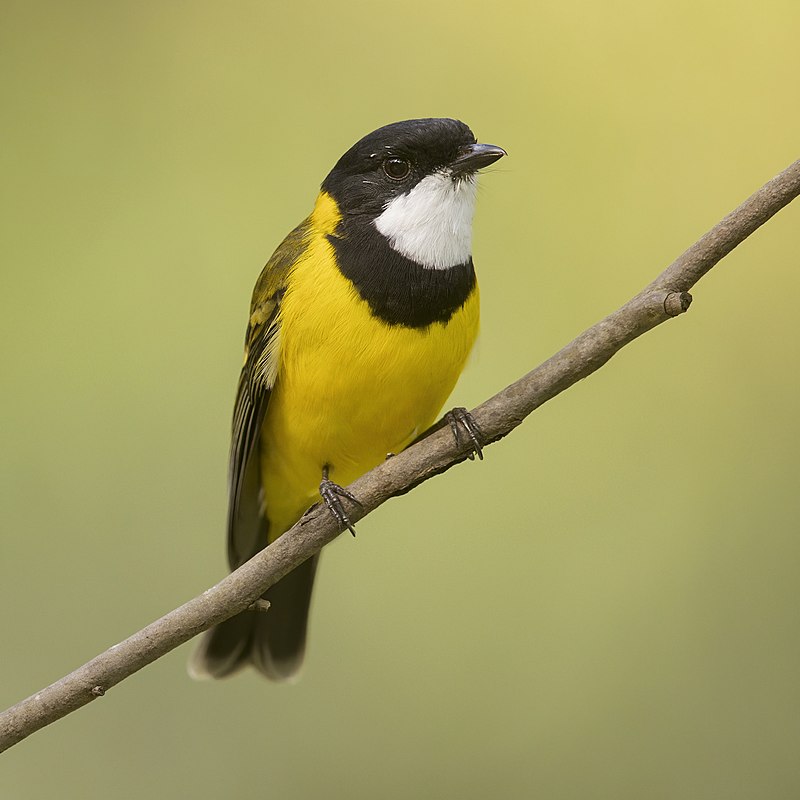
The Australian golden whistler, also known as golden whistler, is a bird species found in various Australian habitats but not in the interior and most part of the north.
They inhabit forest, woodland, mallee, mangrove, and scrub and are mostly residents, but populations in southeastern Australia migrate northwards during winter.
The taxonomy of the Australian golden whistler bird is subject to dispute due to its complex nature.
This beautiful bird has a golden-yellow plumage with a black mask around its eyes, distinctive white eyebrows and throat, and wings and tail with black and white markings.
It is known for its sweet and melodic whistling calls, often heard during breeding season.
Australian golden whistlers mainly feed on insects and fruits, and can be observed foraging in trees and shrubs.
They play an important role in maintaining the ecosystem and are a source of delight for birdwatchers and nature lovers.Scientific classification:
| Kingdom | Animalia |
| Phylum | Chordata |
| Class | Aves |
| Order | Passeriformes |
| Family | Pachycephalidae |
| Genus | Pachycephala |
| Species | P. pectoralis |
Also Featured In: Birds that Live in Gold Coasts,
45. Kangaroo Island Emu
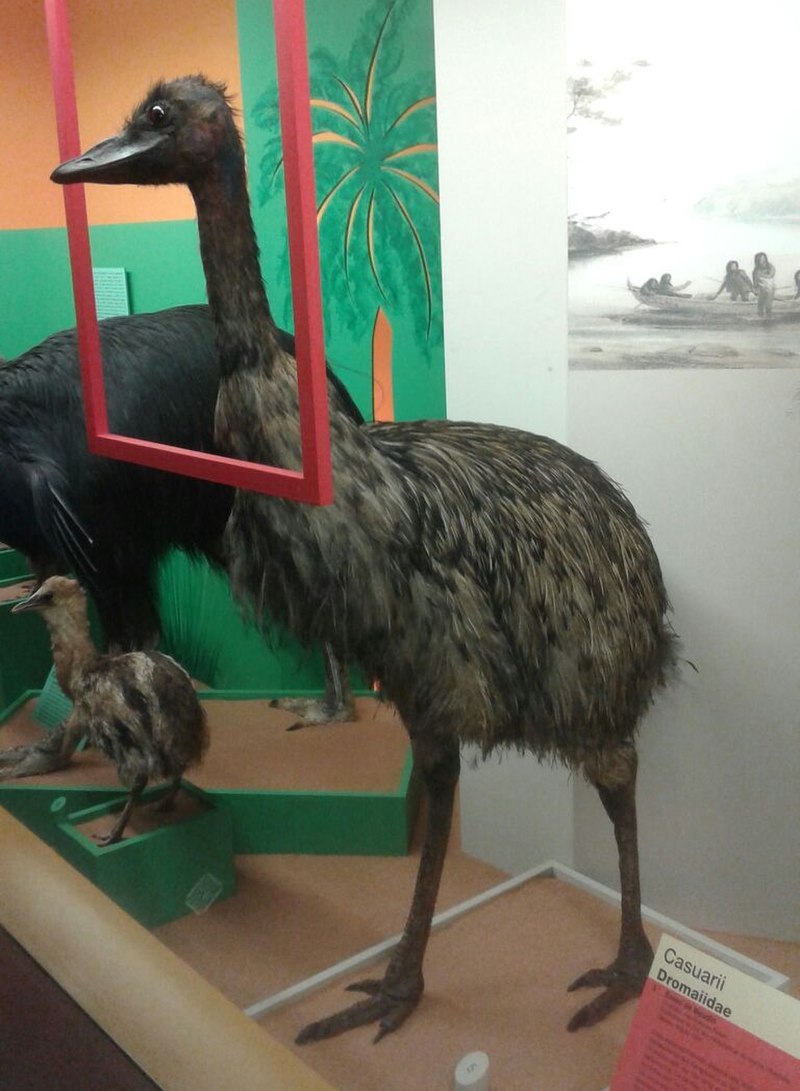
The Kangaroo Island emu, a subspecies of the emu, was native to Kangaroo Island in South Australia. It was smaller than its mainland counterpart and was first noted by Matthew Flinders in 1802.
Sadly, the species became extinct around 1827 and is now only known through historical records and fossils.Scientific classification:
| Kingdom | Animalia |
| Phylum | Chordata |
| Class | Aves |
| Infraclass | Palaeognathae |
| Order | Casuariiformes |
| Family | Casuariidae |
| Genus | Dromaius |
| Species | D. novaehollandiae |
| Subspecies | †D. n. baudinianus |
46. Australasian Robin
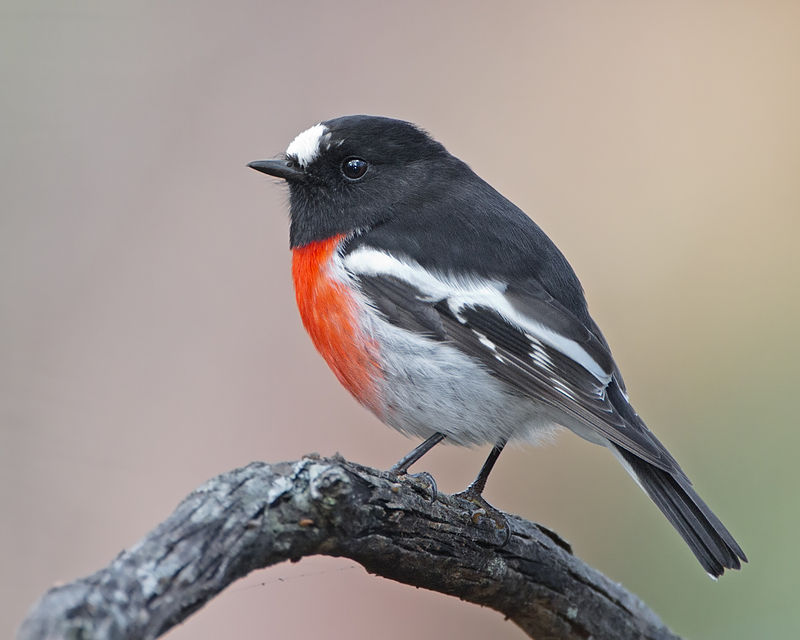
The Australasian robin bird family, consisting of 51 species in 19 different genera, is found only in Australasia. These birds can be found in countries like New Guinea, Australia, New Zealand, and as far east as Samoa.
Despite their name, they are not closely related to the robin birds found in Europe. The Australasian robins are also called scrub-robins and flyrobins and are categorized within the Petroicidae family. They have yet to be given an official common name.
These birds are popular for their melodious singing and attractive appearance. The males have brighter plumage than females, and their nests are often built in trees or other vegetation.
In general, the Australasian robin is a charming and fascinating bird species that are worth watching out for.Scientific classification:
| Kingdom | Animalia |
| Phylum | Chordata |
| Class | Aves |
| Order | Passeriformes |
| Infraorder | Passerides |
| Family | Petroicidae Mathews, 1920 |
47. Australian Reed Warbler
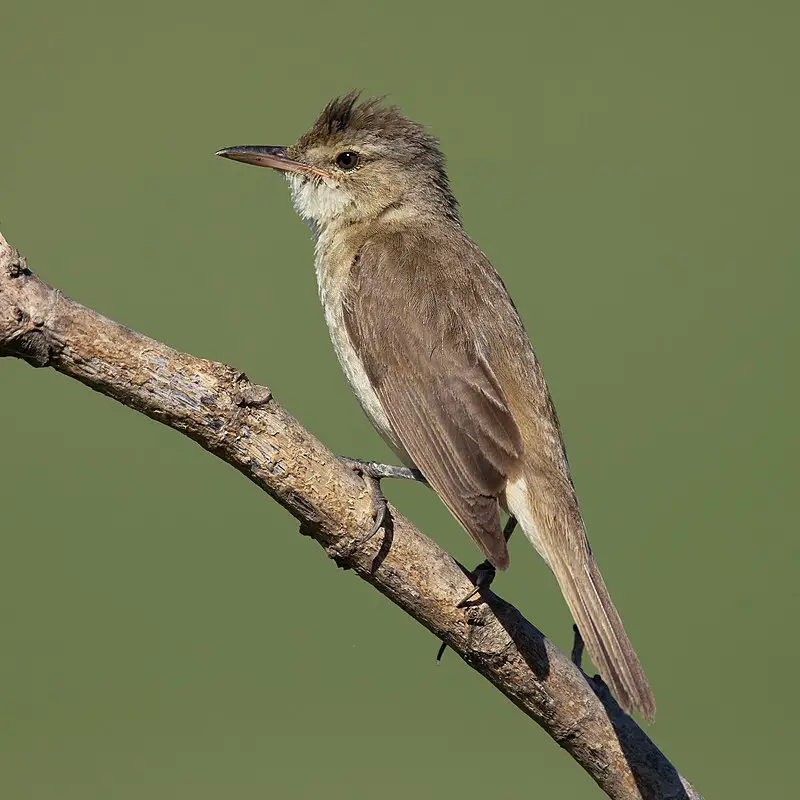
The Australian reed warbler is a unique species of bird found only in Australia, though it has also been spotted in Papua New Guinea and nearby islands.
It belongs to the Acrocephalus genus, which is characterized by their peaked crown. The term Acrocephalus is of Greek origin and literally means “topmost head.” The Australian reed warbler is the only species within this genus native to Australia.
This tiny bird is an Old World warbler and is known for its melodious whistling songs, which can be heard in the dense reed beds it calls home. Despite its small size, it is a skilled navigator and often migrates long distances each year.
This bird is a treasured part of Australia’s unique birdlife and is loved by birdwatchers and conservationists alike.Scientific classification:
| Kingdom | Animalia |
| Phylum | Chordata |
| Class | Aves |
| Order | Passeriformes |
| Family | Acrocephalidae |
| Genus | Acrocephalus |
| Species | A. australis |
48. Crescent Honeyeater
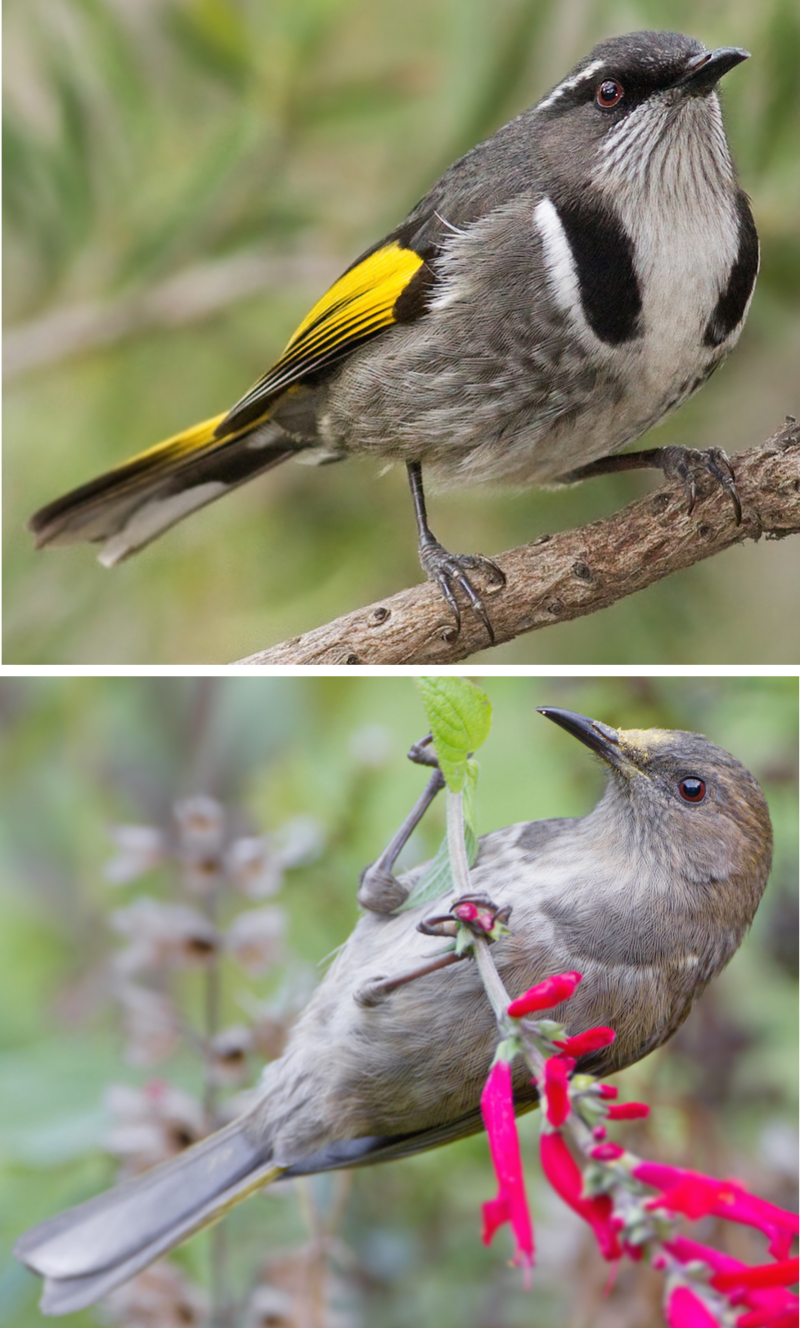
The crescent honeyeater is a lovely passerine bird that can be found in southeastern Australia. As a member of the Meliphagidae family, it is closely related to the New Holland honeyeater and the white-cheeked honeyeater.
The species is comprised of two recognized subspecies, with one of them being restricted to Kangaroo Island. With its vibrant colors and intricate patterns, the crescent honeyeater is a beautiful addition to any natural setting.
While the bird is native to Australia, it is not uncommon to spot it in other parts of the world, making it a fascinating animal to observe.
When it comes to its habitat, the crescent honeyeater tends to prefer areas with trees and plenty of flowers, as it feeds on nectar and insects.
Overall, this bird is admired for its distinct appearance and its importance to nature.Scientific classification:
| Kingdom | Animalia |
| Phylum | Chordata |
| Class | Aves |
| Order | Passeriformes |
| Family | Meliphagidae |
| Genus | Phylidonyris |
| Species | P. pyrrhopterus |
49. White-Browed Woodswallow
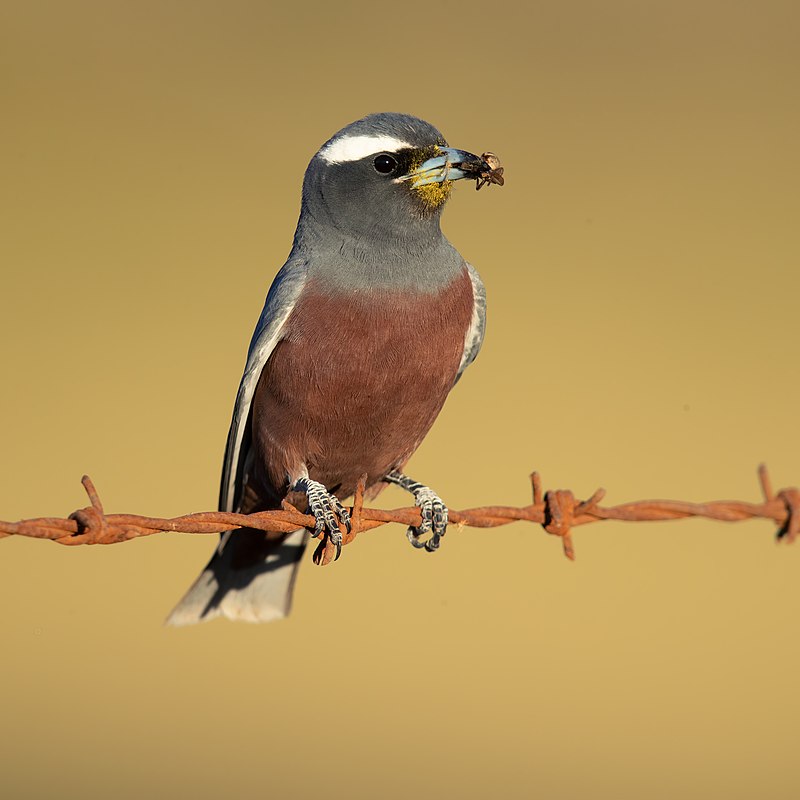
The White-browed Woodswallow is a bird native to Australia. It is of medium size, measuring around 19 cm in length.
It has a black head with a distinctive white brow, and its upper body is a deep blue-grey color, while its underbody is chestnut in color.
Females of this species are paler than males. The White-browed Woodswallow’s tongue is bifurcated, or divided.Scientific classification:
| Kingdom | Animalia |
| Phylum | Chordata |
| Class | Aves |
| Order | Passeriformes |
| Family | Artamidae |
| Genus | Artamus |
| Species | A. superciliosus |
50. Double-Banded Plover
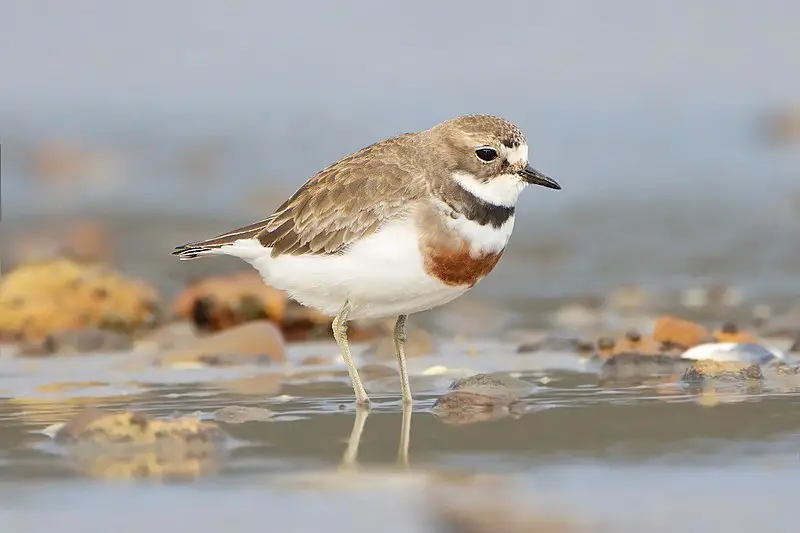
The double-banded plover, also known as banded dotterel or pohowera, is a bird species in the plover family. This bird has two recognized subspecies, one of which breeds in New Zealand and the other in the subantarctic Auckland Islands.
The bird is famously known for its distinctive double banding on its neck and breast, which makes it easily distinguishable from other plovers.
Despite being a small bird, it has quite powerful legs, which are used in running and foraging for food.
The double-banded plover is a migratory bird, and it breeds throughout New Zealand, including Chatham Islands.
It is estimated that there are currently around 10,000 to 25,000 mature double-banded plovers in the wild.Scientific classification:
| Kingdom | Animalia |
| Phylum | Chordata |
| Class | Aves |
| Order | Charadriiformes |
| Family | Charadriidae |
| Genus | Charadrius |
| Species | C. bicinctus |